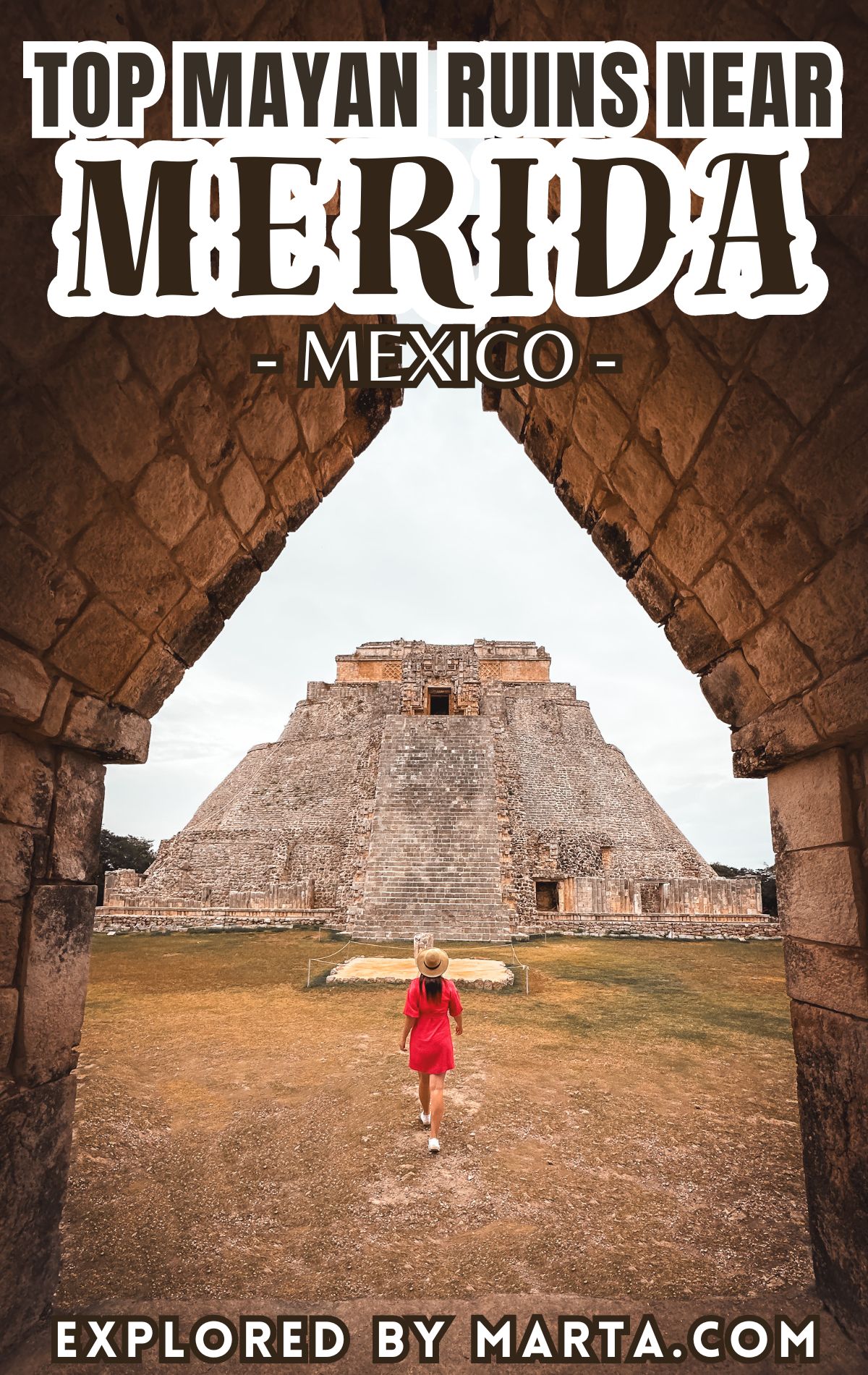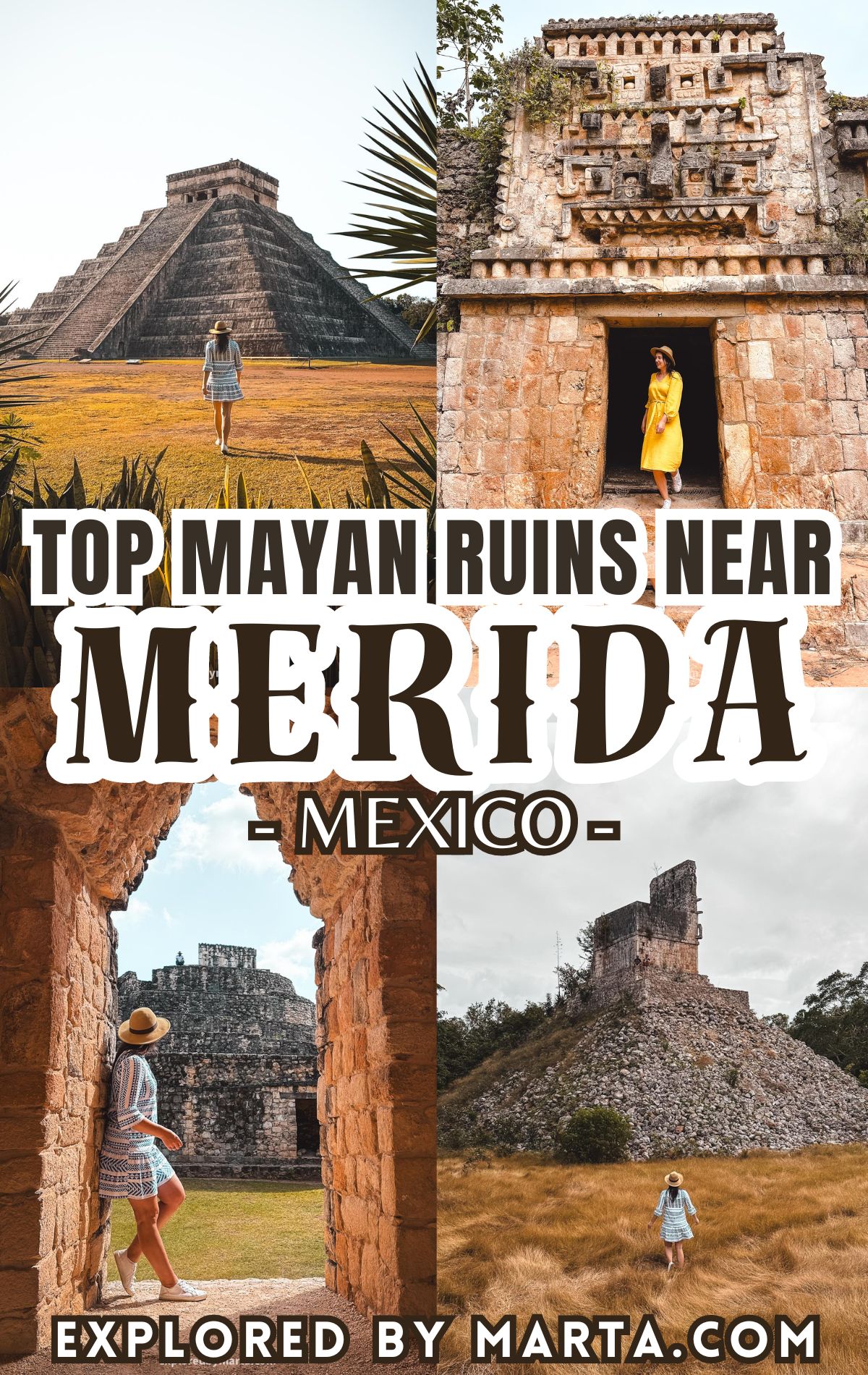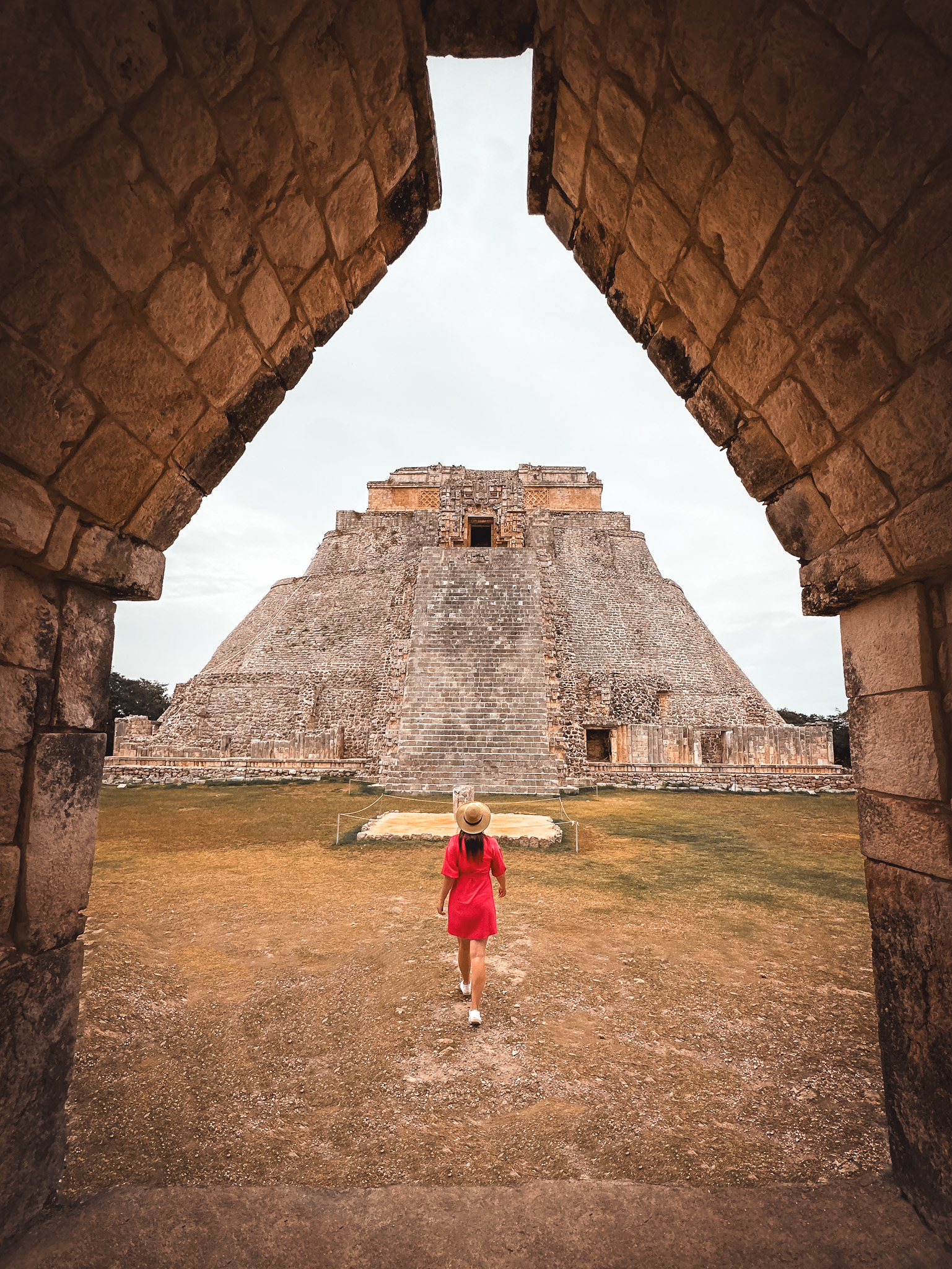11 most beautiful Mayan ruins near Merida, Mexico
This post may contain affiliate links. If you use these links to buy something I may earn a small commission at no extra cost to you! Thank you for your support!
Discover the most beautiful Mayan pyramids and Mayan ruins near Merida, Mexico! From the world-famous Chichen Itza ruins to the secret archaeological sites along the Ruta Puuc, I was totally amazed by all the ancient cities hidden in the jungle!
Merida is the perfect place to embark on a day tour to explore the Mayan culture through all the archaeological zones near Merida. We had a rental car and went everywhere ourselves but it is possible to join a tour, go by bus or even taxi.
In this blog post, you will find all the best Mayan ruins near Merida, Mexico with descriptions, photos, and locations on the map. If you are staying for a longer while in Merida just like we did, this blog post will come in handy for you! Happy travels!
Read more » Ring of Cenotes: 15 beautiful cenotes near Merida, Mexico
1. Chichén Itzá
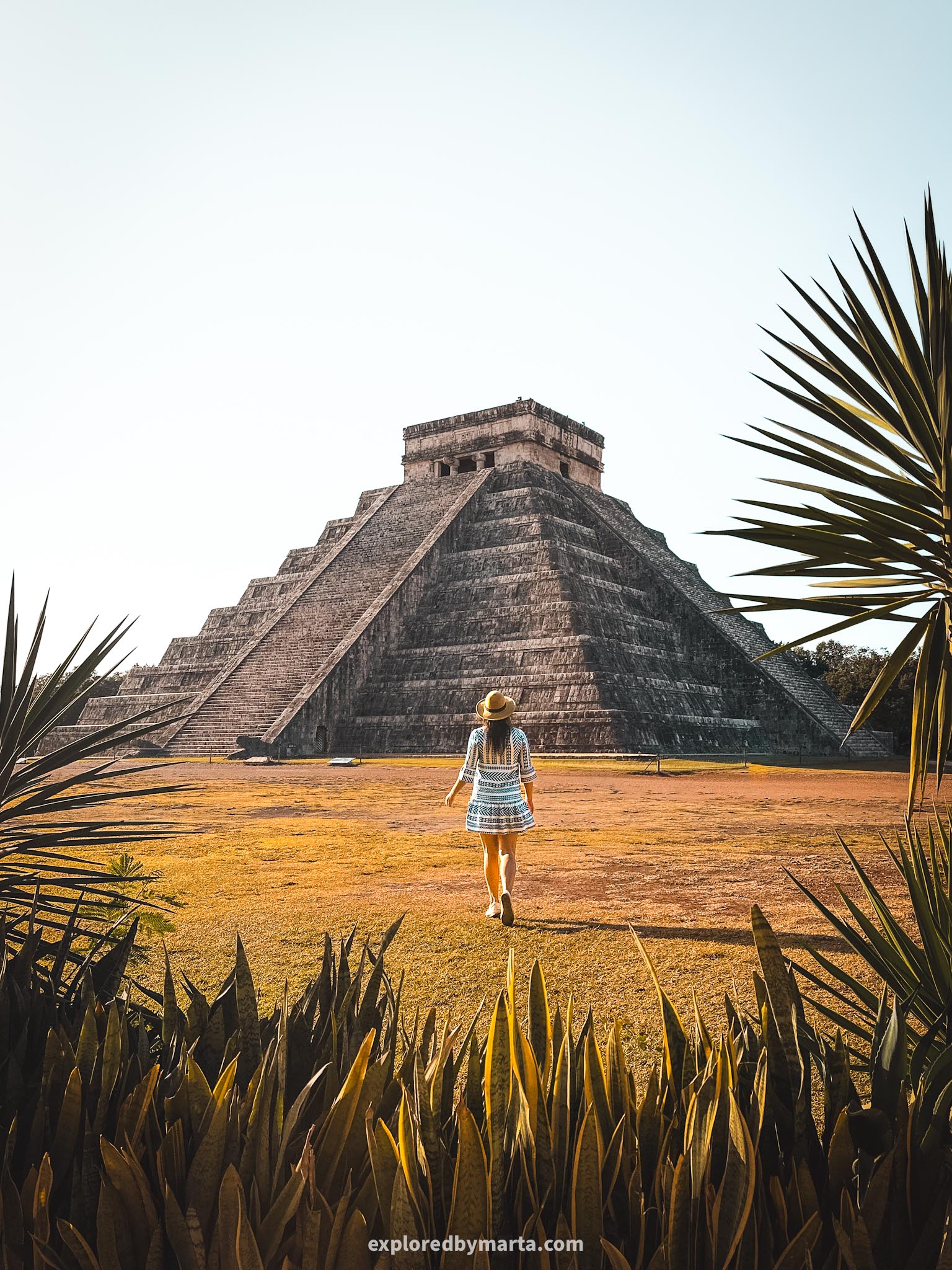
Exploring the ancient cities and Mayan ruins was one of my favorite things to do in Merida and, to no surprise, Chichen Itza was the most glorious archaeological site of them all!
Chichen Itzá is the most famous archaeological site in the Yucatán Peninsula and one of the most visited archeological sites in Mexico. It was declared a UNESCO World Heritage Site and was voted as one of the New Seven Wonders of the World in 2007.
Chichén Itzá was one of the largest Mayan cities dating back to 600 AC. It existed as a major regional center for many centuries until its decline by the 12th century. It still operated until the Spanish conquistadors arrived in the 16th century.
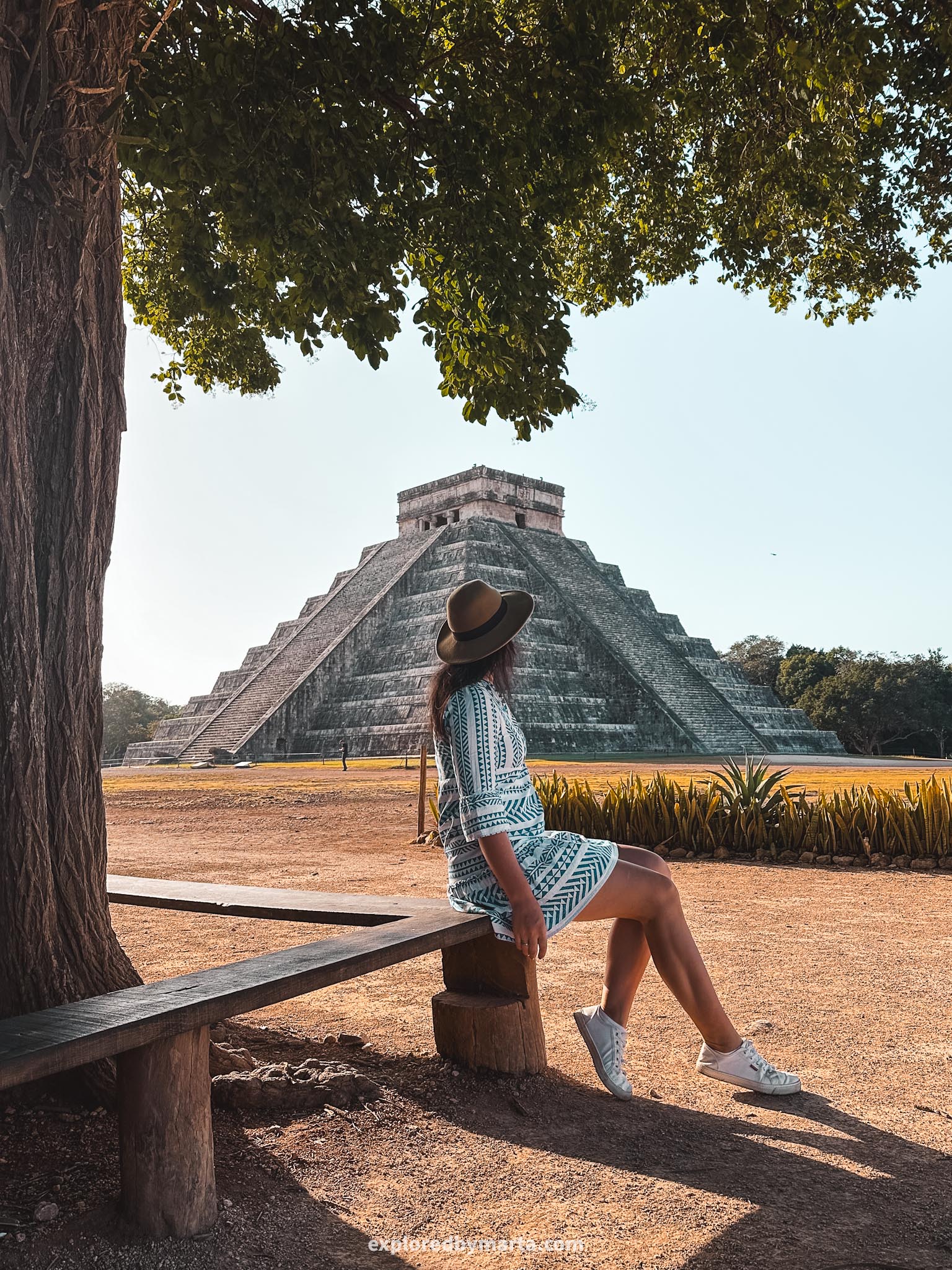
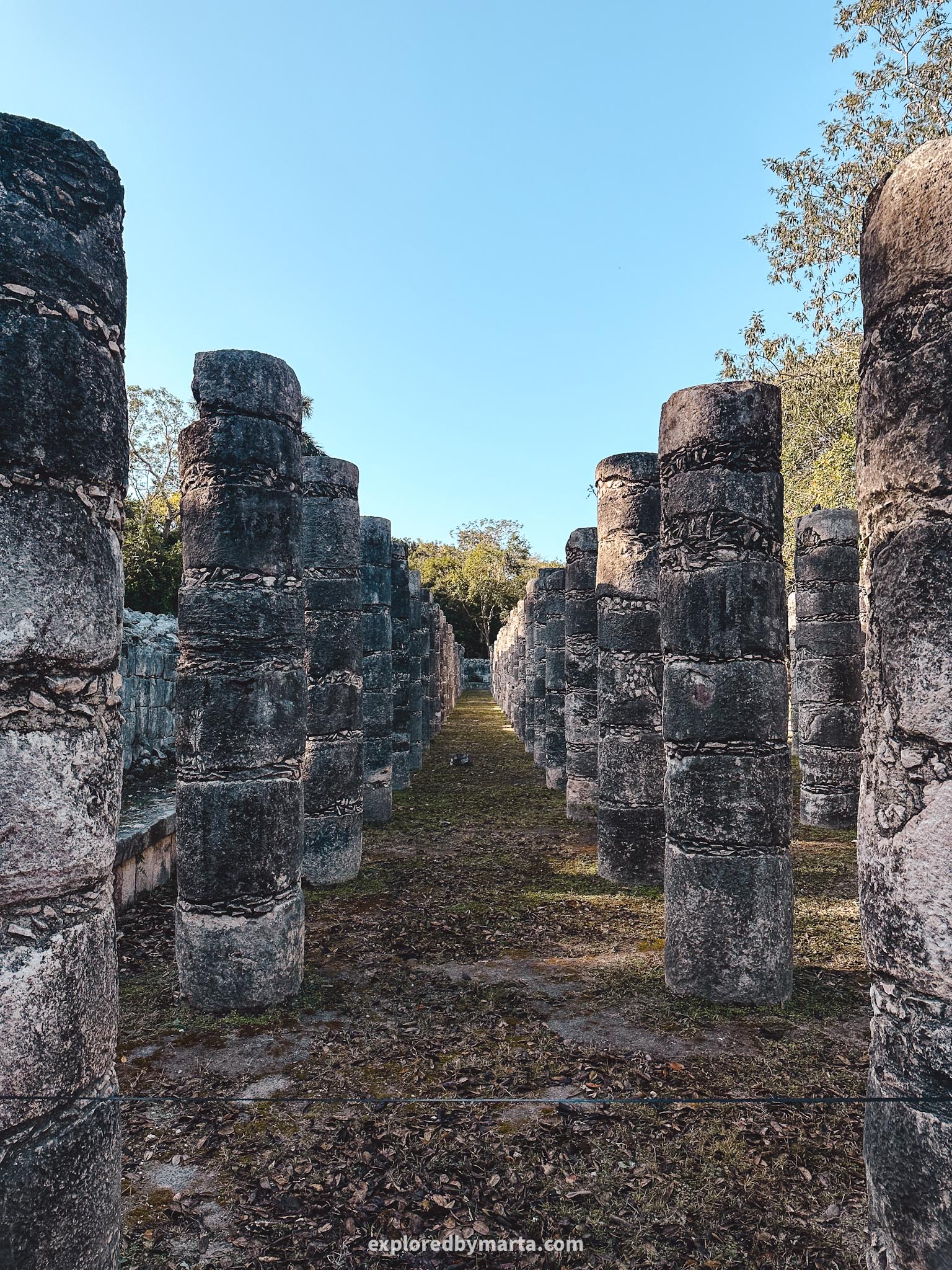
Chichén Itzá archaeological zone consists of multiple temples, pyramids, structures, and even a sacred cenote (cenote sagrado) where Mayans deposited valuables and gifts including human sacrifices as a form of sacrifice to their rain god Chaac.
The most famous structure is, of course, the great pyramid El Castillo (the castle) which is also known as the Temple of Kukulcan. The pyramid with the temple on top of it is 30 meters high and was built sometime between the 8th and 12th centuries.
Interestingly, when you clap your hands in front of the staircase of the pyramid, the echo of the sound mimics the voice of the quetzal bird. The same effect happens at another large pyramid in the Yucatán Peninsula – Uxmal.
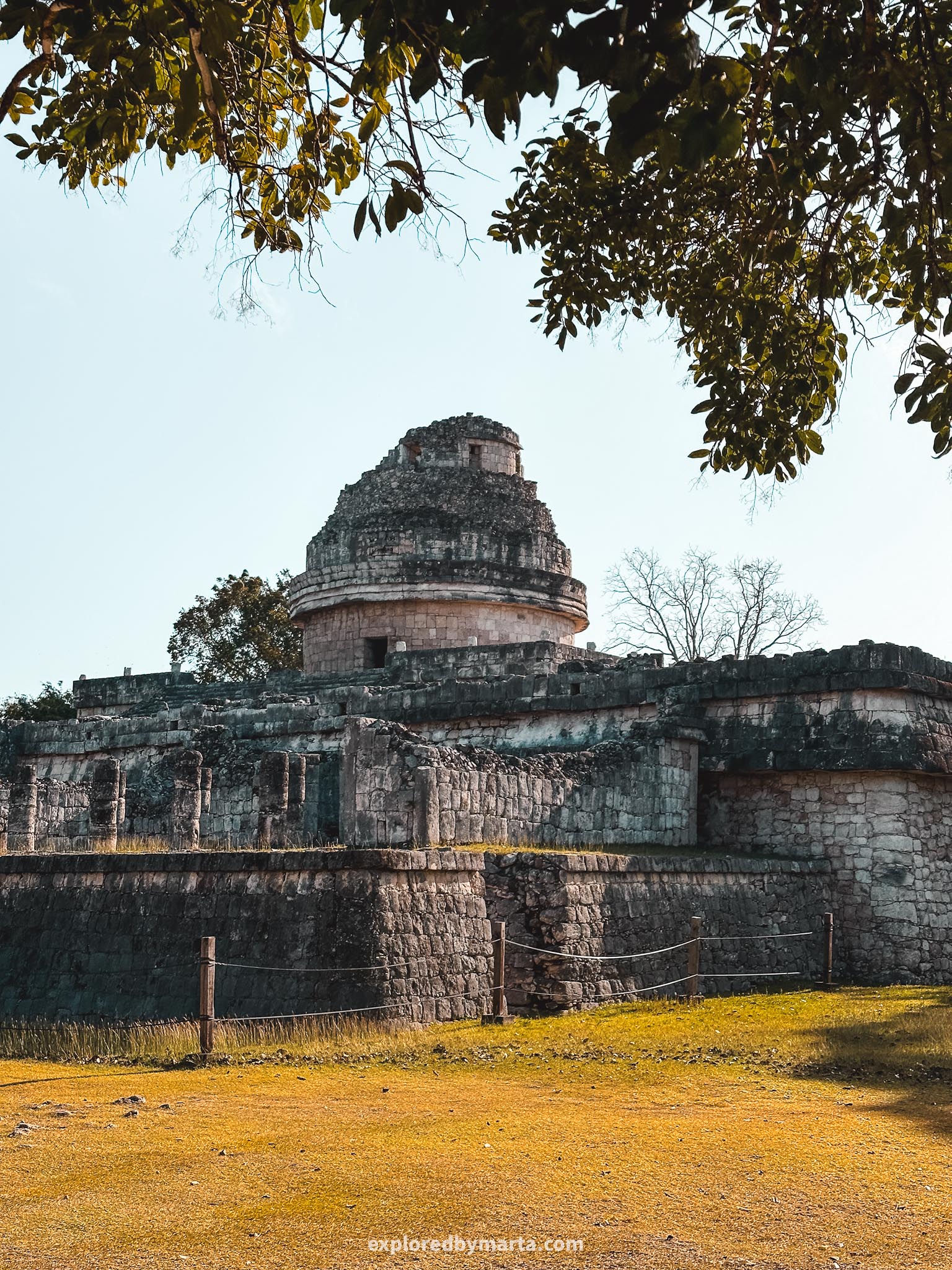
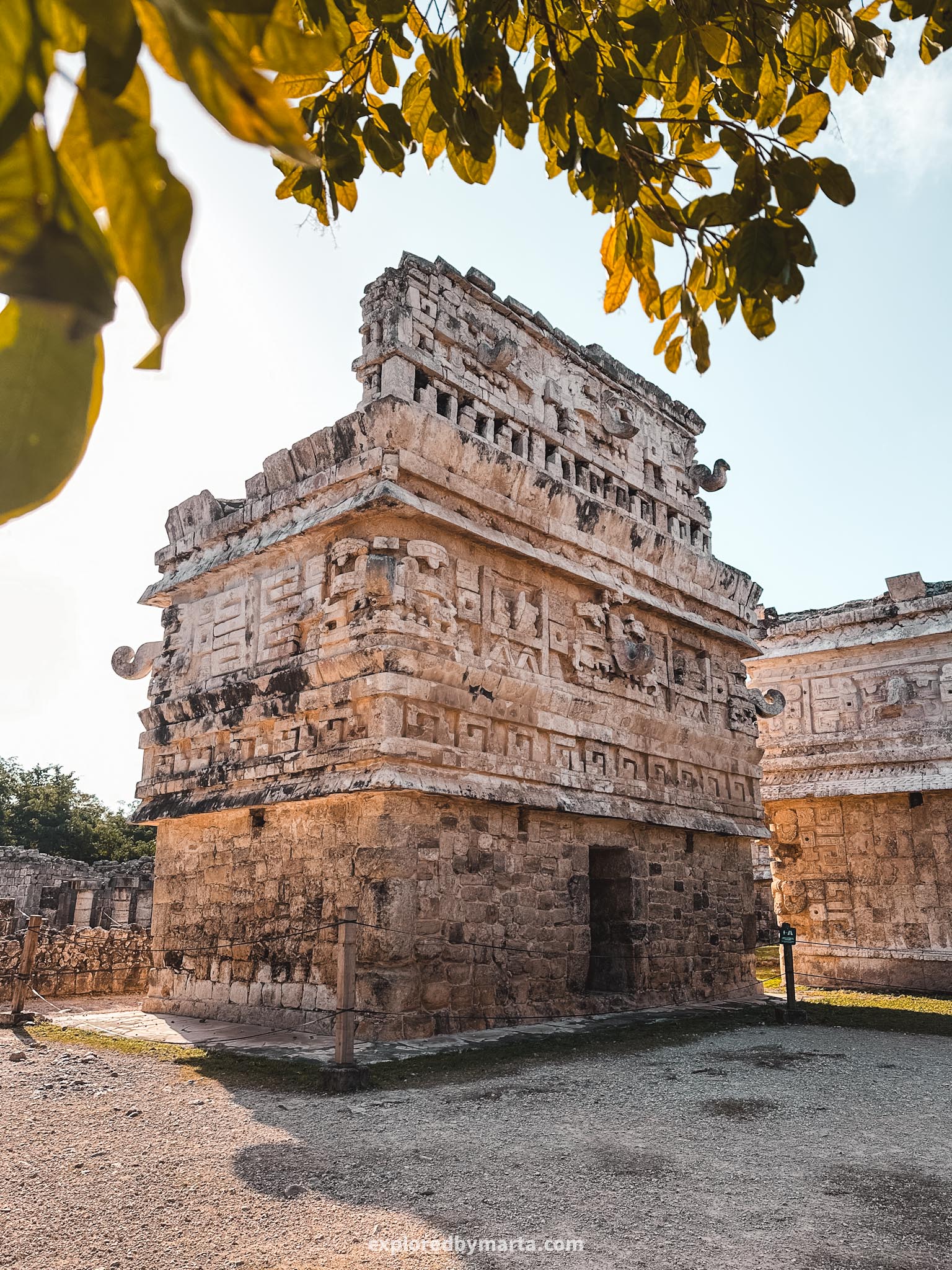
Besides the Chichen Itza pyramid, other structures nearby include the Temple of the Warriors with a group of a thousand columns around it, the Temple of the Great Tables, the Ballcourt, and the Eagles and Jaguars platform.
A little bit further away you will find one of my favorite buildings – El Caracol (the snail) which is a Mayan observatory dating back to the 10th century. Next to it, there is a building complex – Las Monjas – boasting an extravagant Puuc architectural style.
Visiting the Chichen Itza pyramid site is one of the bucket list things to do in the Yucatán Peninsula. It comes with its challenges – the site is a popular destination and always gets crowded so I recommend arriving first thing in the morning.
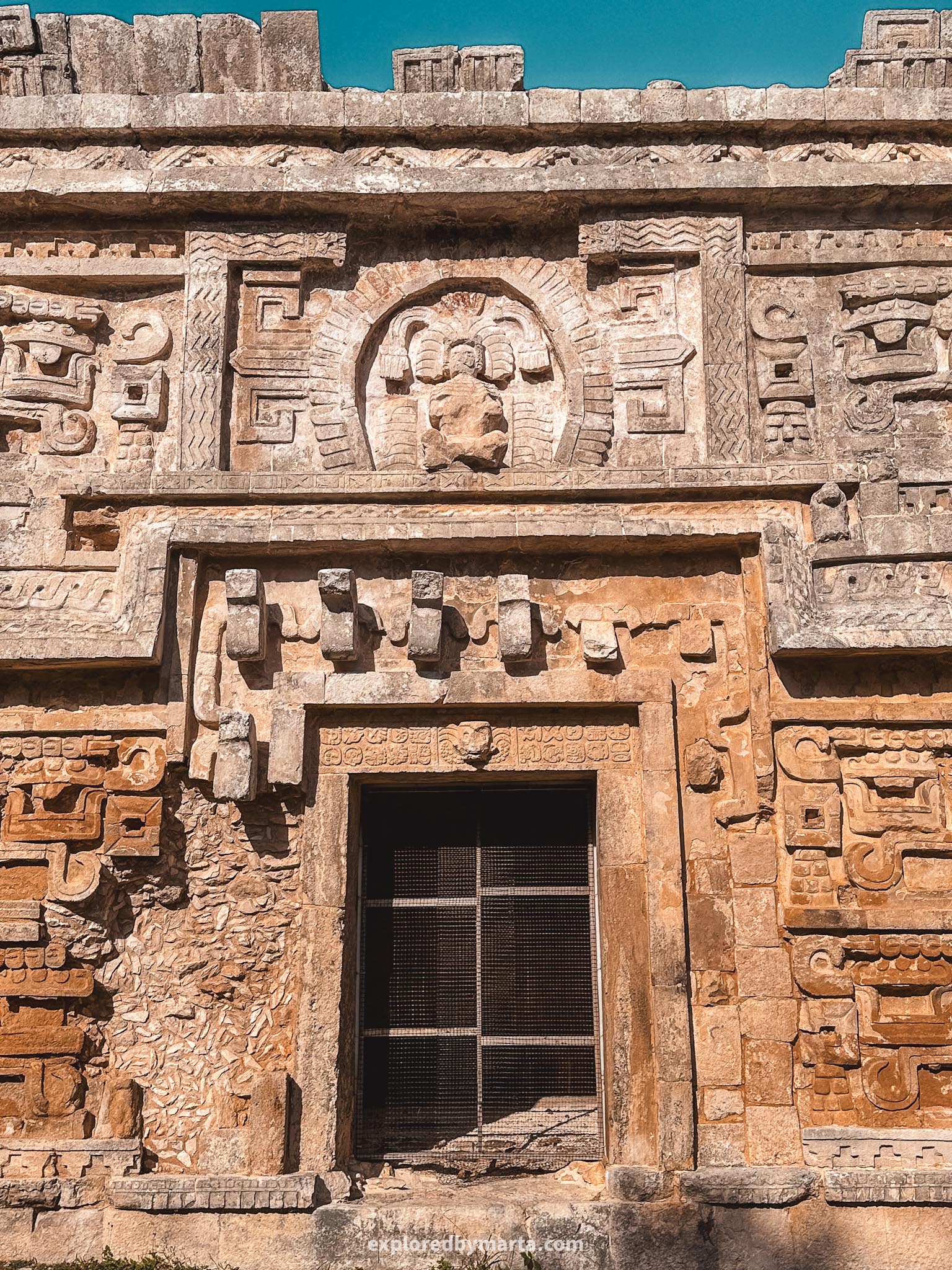
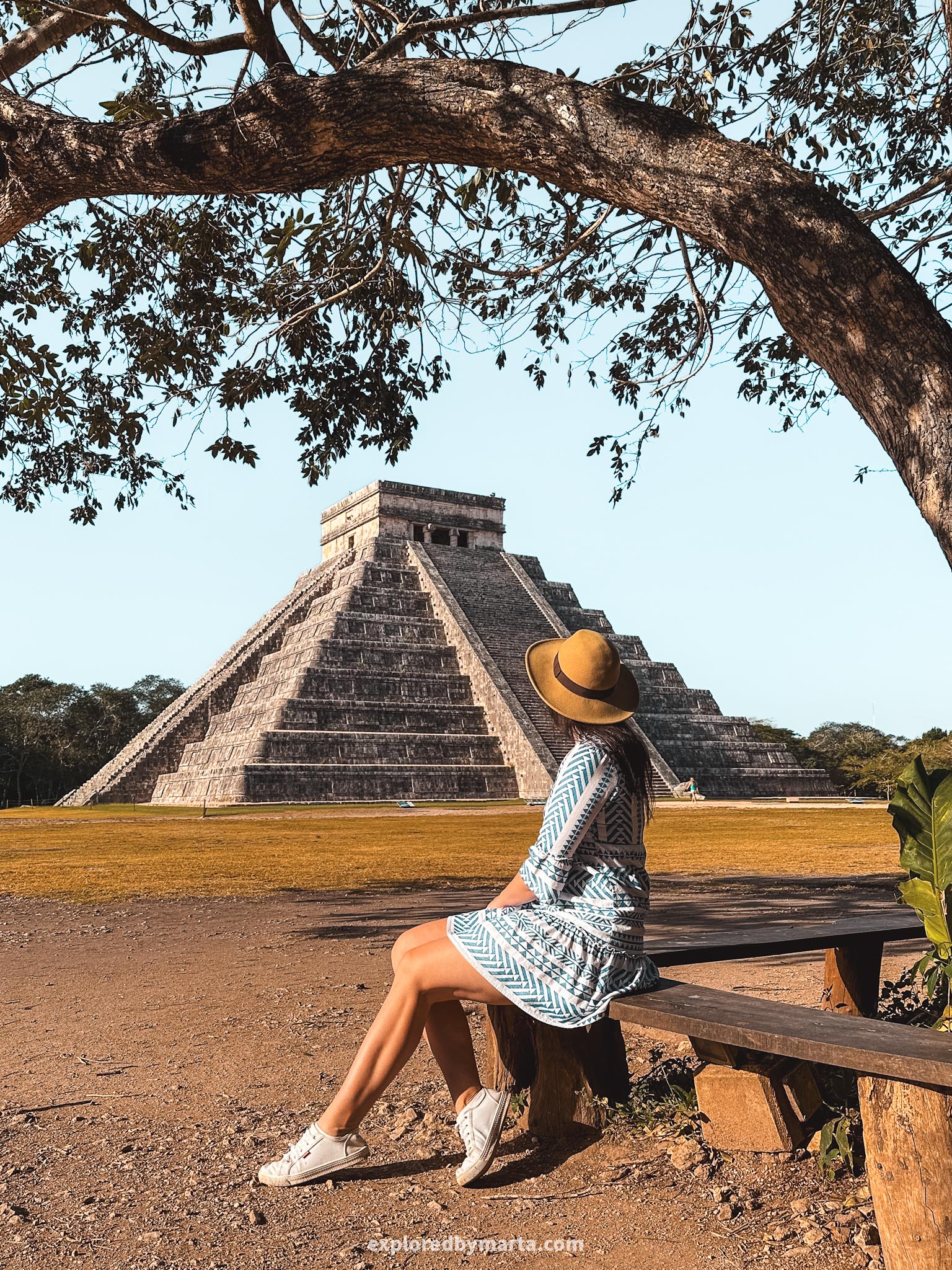
The site opens at 8 AM, the parking next to the entrance opens at 7:30 AM. We arrived even before that so that we could be amongst the first ones in. At 8 AM there was already a long line of people so it is best if you have a car and can arrive early.
For parking, we paid more than 100 pesos (in cash) but for the entrance fee (by card) we paid more than a staggering 620 pesos each. If you want, you can hire a guide on the spot (extra fee) who will tell you the history and take you all around the site.
You can’t climb any of the Mayan ruins on this site which is understandable. However, there are other Mayan ruins near Merida or around Yucatán where you are allowed to climb – like the next site on this list, Ek Balam, just a 1-hour drive from Chichen Itza!
Location: Chichén Itzá
2. Archaeological Zone of Ek Balam
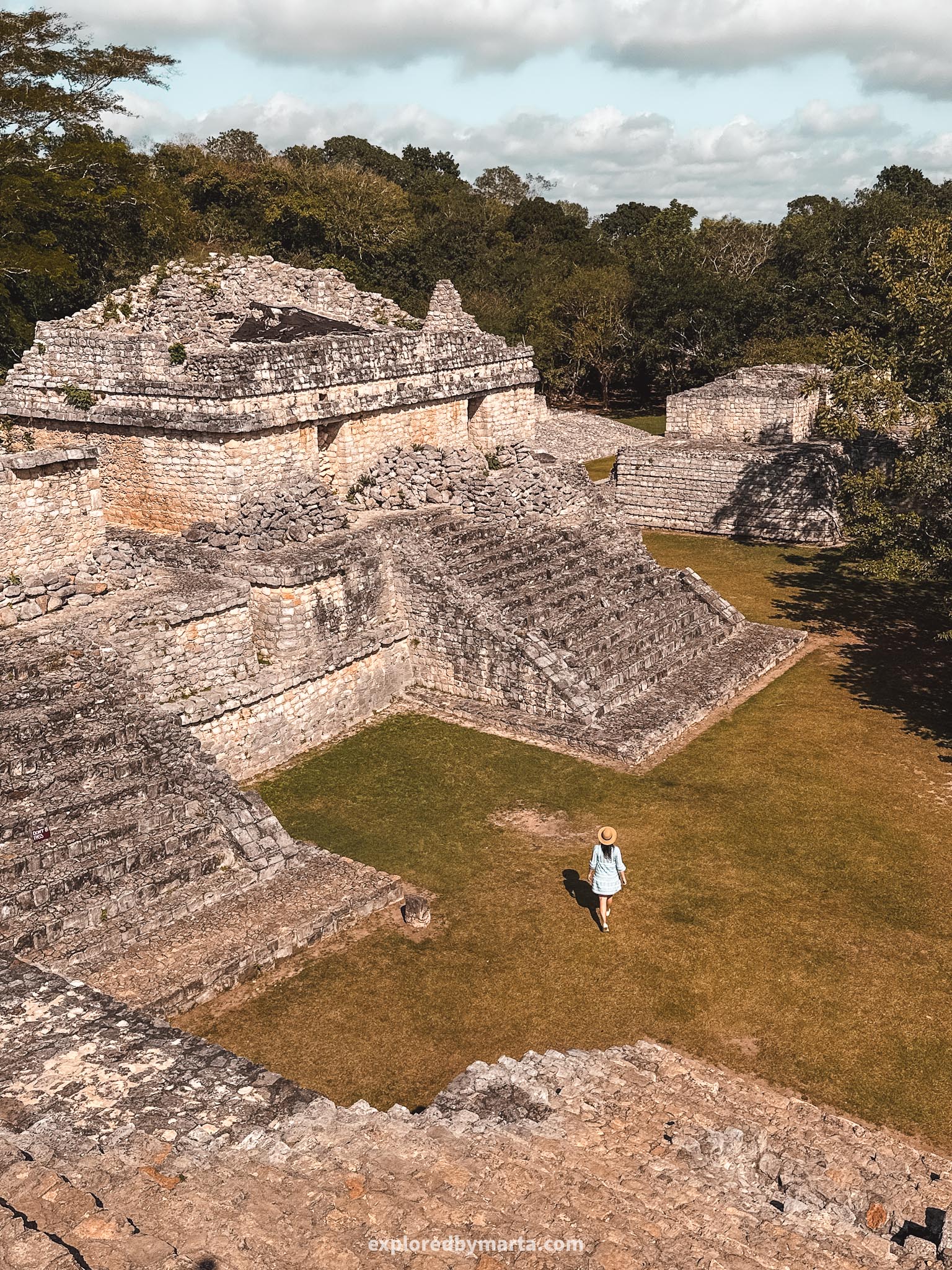
Ek Balam Mayan ruins is one of the most important sites in Mexico’s Yucatán Peninsula. Let’s start with the best part about it – you can climb the Mayan ruins and pyramids! Not all of them but enough to enjoy amazing views over the jungle.
Them allowing us to climb the pyramids kind of offsets the massive entrance fee – we paid 550 pesos each plus 100 pesos for parking. Theoretically, you can pay by card (entrance fees) but because of the bad network, we ended up paying in cash.
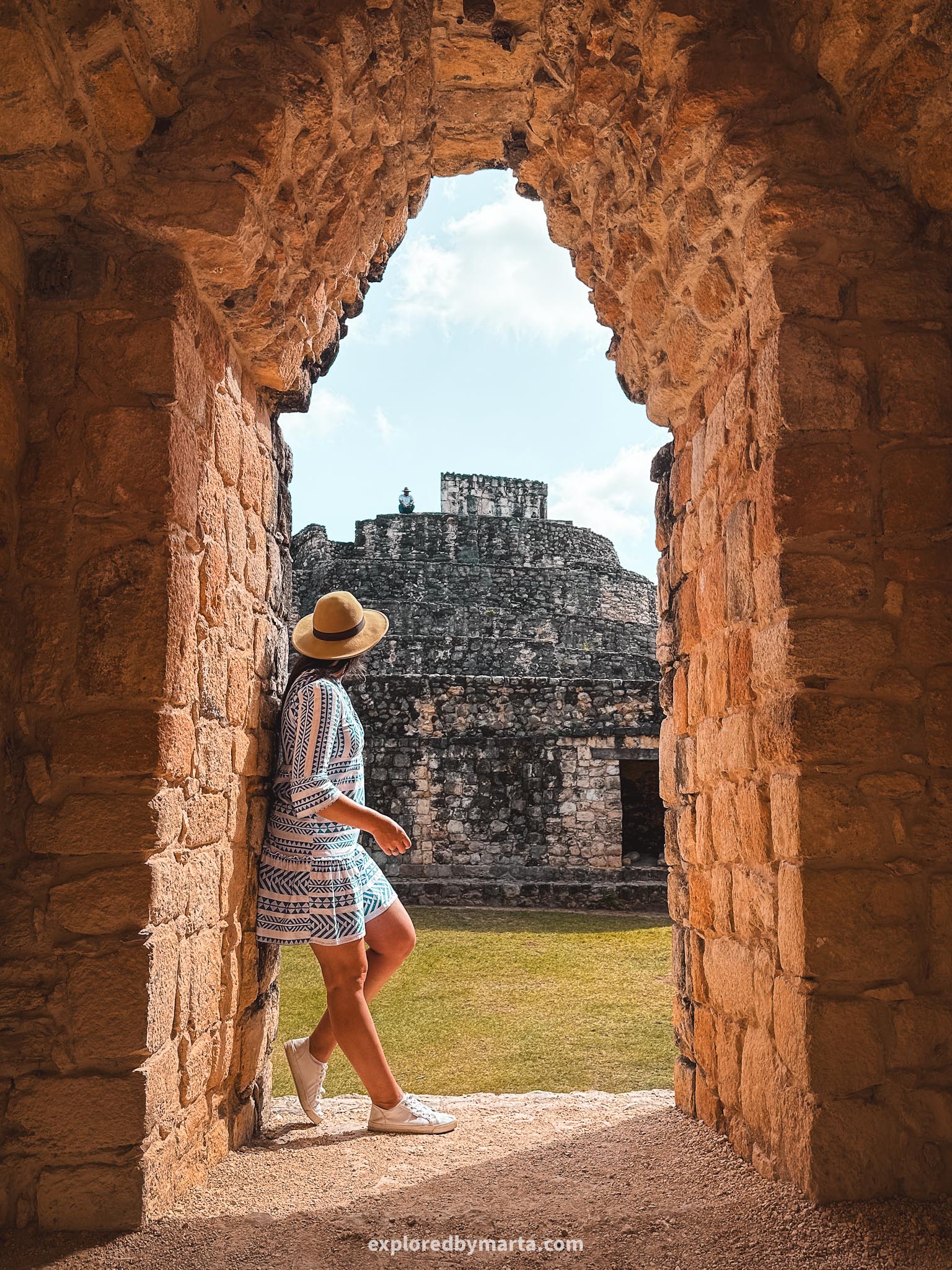

Ek Balam is located a short drive away from Valladolid and a 2-hour drive from Merida. The name Ek Balam translates as the black jaguar or the jaguar star in the Yucatecan Mayan language. That’s why you will see many black jaguar souvenirs on the site.
Ek Balam site features multiple impressive buildings and pyramids. The largest structure in Ek Balam is the Acropolis. It is like a temple pyramid with a staircase in the middle where you can climb up to the top to see incredible views over the jungle.


To both sides of the central staircase, you can find entrances to temples decorated with stone carvings and mosaics. They are believed to be burial places for Ek Balam rulers. One of the entrances depicts an open mouth of a jaguar (photo above).
Other notable structures in Ek Balam include the Oval Palace (you can climb it), the Entrance Arch, The Twins, or two lookalike temples, as well as the Ballcourt. Ek Balam was a booming city during the 8th and 9th centuries.

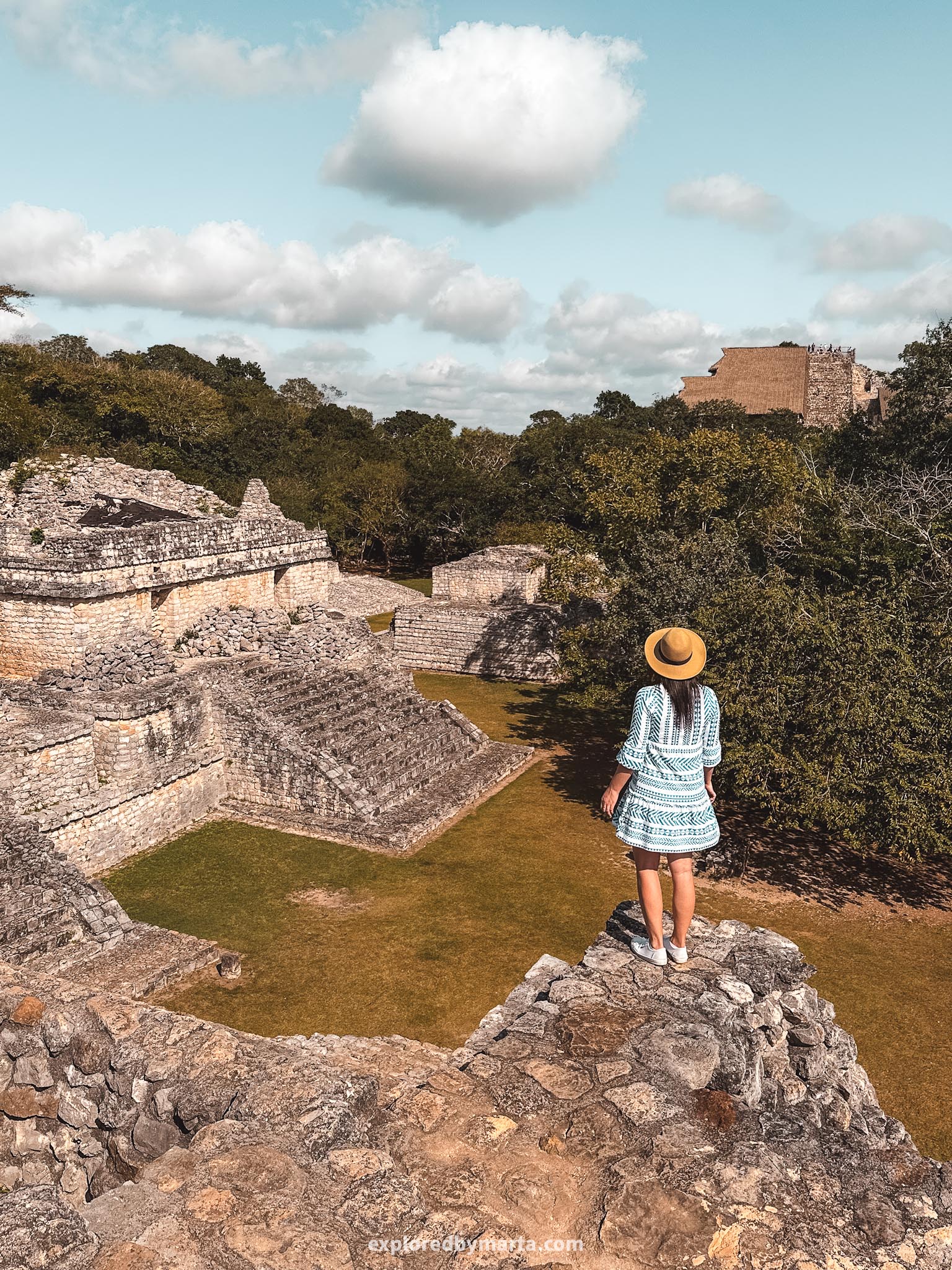
Overall I liked exploring Ek Balam. These weren’t my favorite Mayan ruins mostly because of the inflated entrance fee but I also don’t regret coming here. It is always cool to explore how the Mayan civilization lived before the Spanish found them.
Ek Balam is not the only place where you can climb Mayan pyramids. Read along to see more places where you can explore some of the Yucatán ruins up close, including climbing up to the top of some of those iconic pyramids!
Location: Archaeological Zone of Ek Balam
3. Ruta Puuc: Uxmal Archaeological Zone
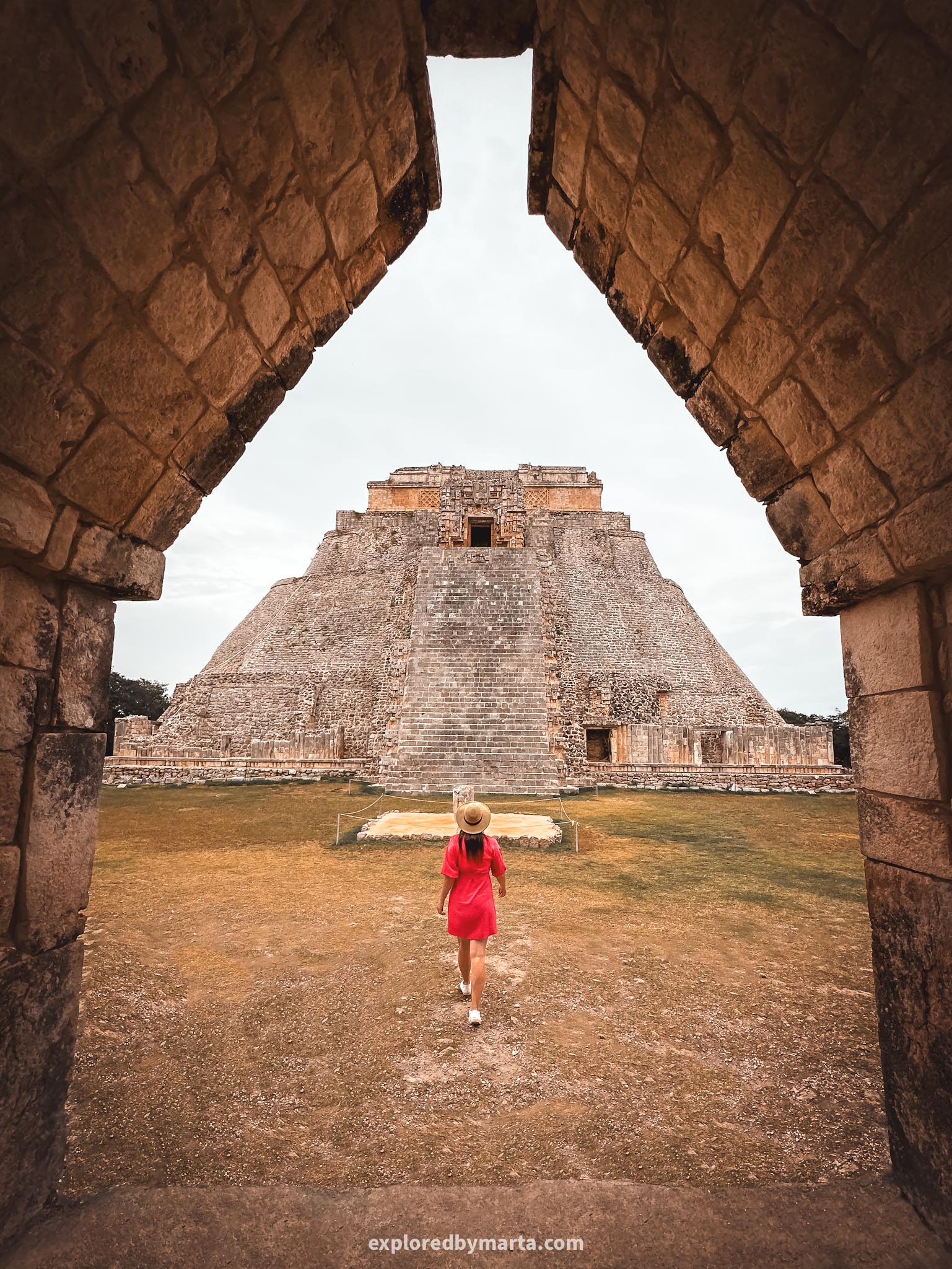
Now, this is the place to find those iconic Merida Instagram spots! The photo-perfect Uxmal archaeological zone with its 40-meter-high Pyramid of the Magician dates back to the 10th-11th centuries and is amongst the most famous Mayan ruins in Yucatán.
What is Ruta Puuc? Uxmal ruins are also part of Ruta Puuc – a group of special Mayan ruins in Yucatán featuring the Puuc architectural style. Puuc means ‘hills’ in the Mayan language and is also the name of the region where all these ruins are located.
Puuc architecture usually displays stone mosaics, geometrical elements, and elaborate sculptures e.g. it often features masks of the long-nosed rain god Chaac. It also features stone arches in unique shapes (see the frame in the first photo).

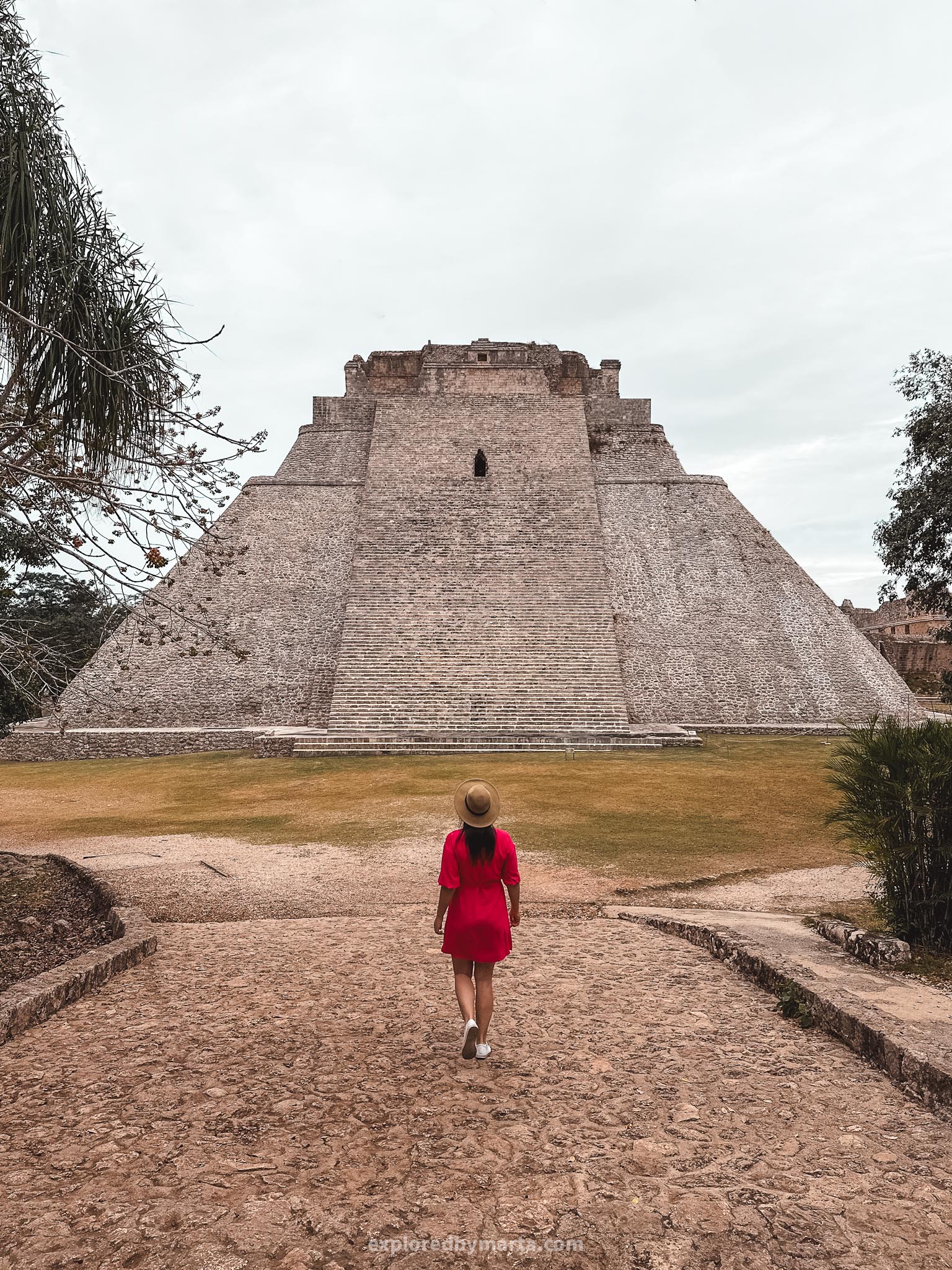
Uxmal archaeological zone and the whole Ruta Puuc (see the next sites on this list) is one of the most popular Merida day trips. We did exactly that as we rented a car and visited Uxmal on a day trip during our three-week stay in the city of Merida.
Uxmal is undoubtedly one of the best Mayan ruins you will find in the Yucatán Peninsula and definitely the most impressive Mayan ruins near Merida. The whole archaeological zone is listed as a UNESCO World Heritage Site due to its significance.
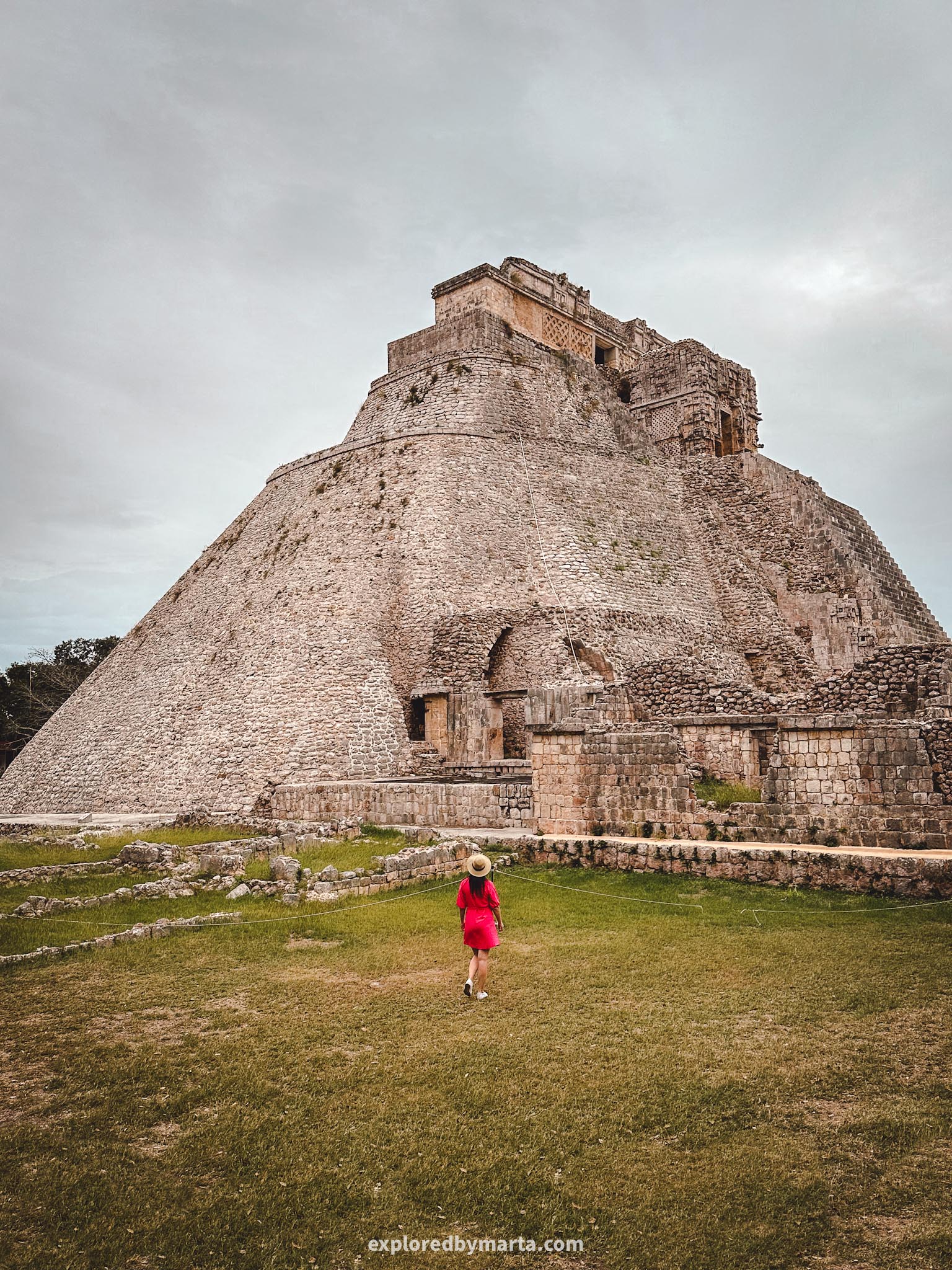
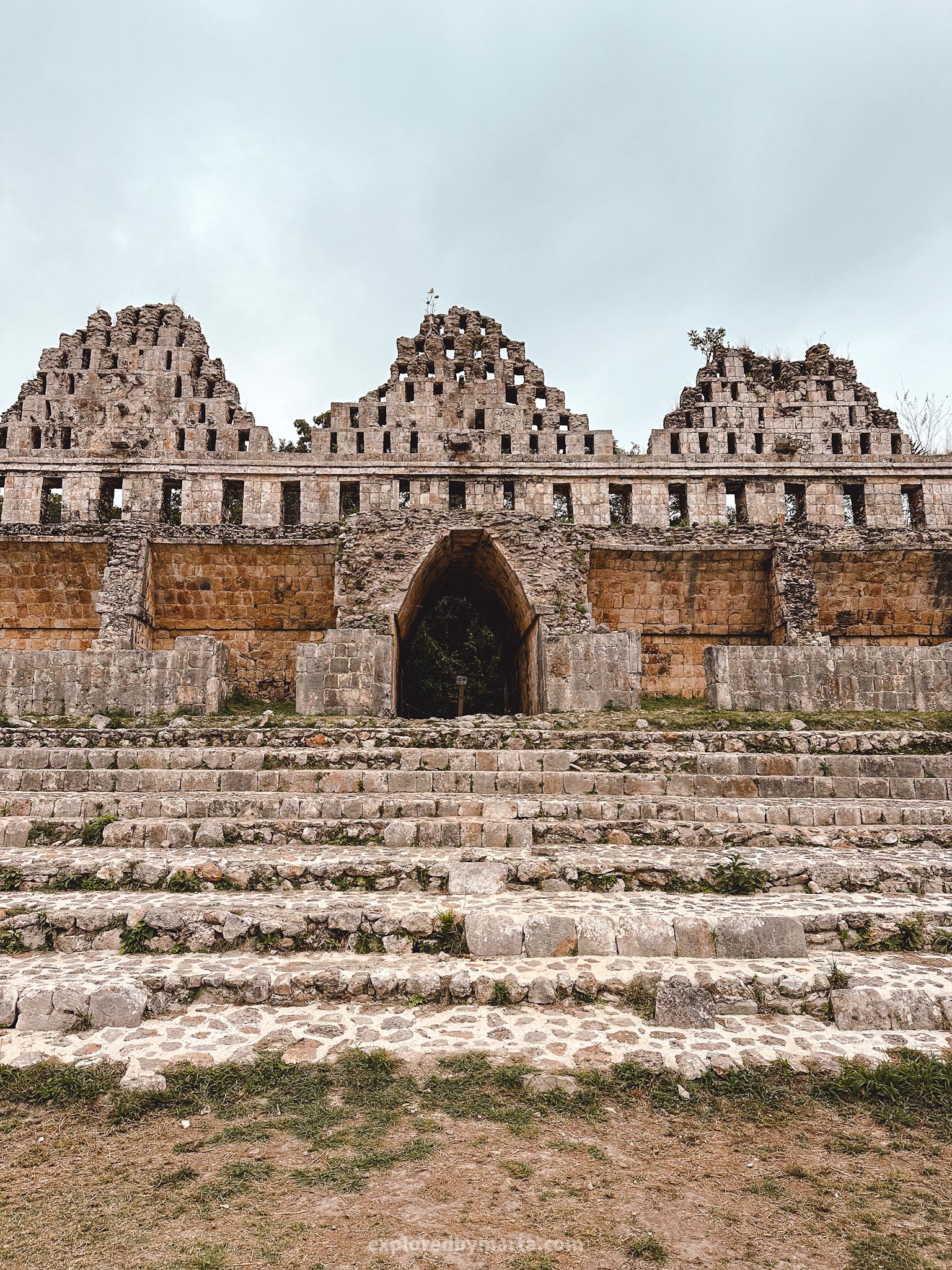
The Pyramid of the Magician is the most famous structure in Uxmal. The legend says that the pyramid was built in one night however there are various versions of who actually built it – a dwarf, a magician, or somebody else.
The pyramid has a unique feature – if you clap your hands in front of the pyramid the structure creates an echo of the clap that sounds like quetzal – a strikingly beautiful and colorful bird that is sacred to Mayan people. Such a unique experience!
By the way, the best place to take a photo of the pyramid and observe it closer is from behind it. There is a large square called Cuadrangulo de los Pajaros or Bird Quadrangle that is surrounded by buildings and walls. This is where the first photo was taken.
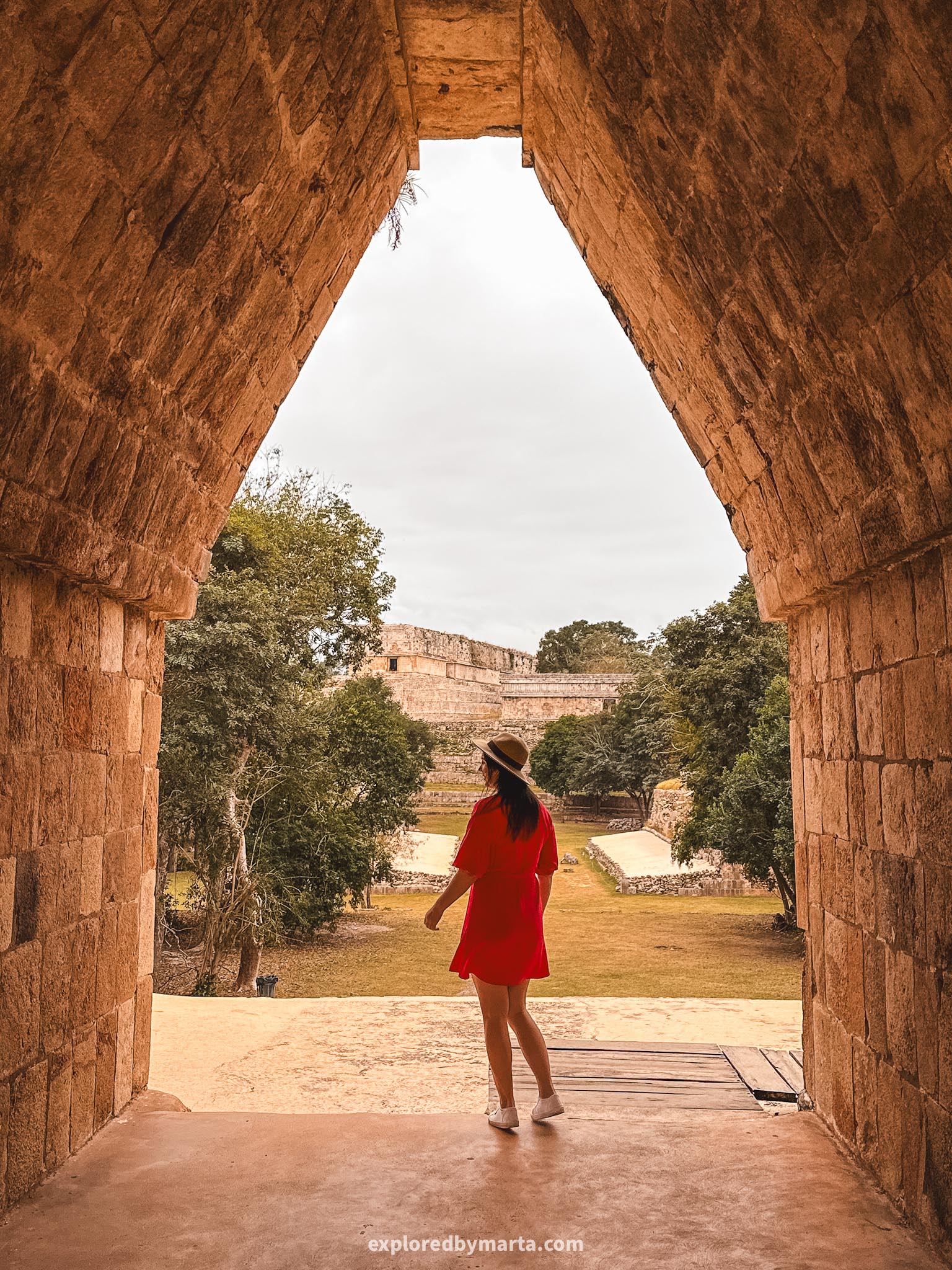
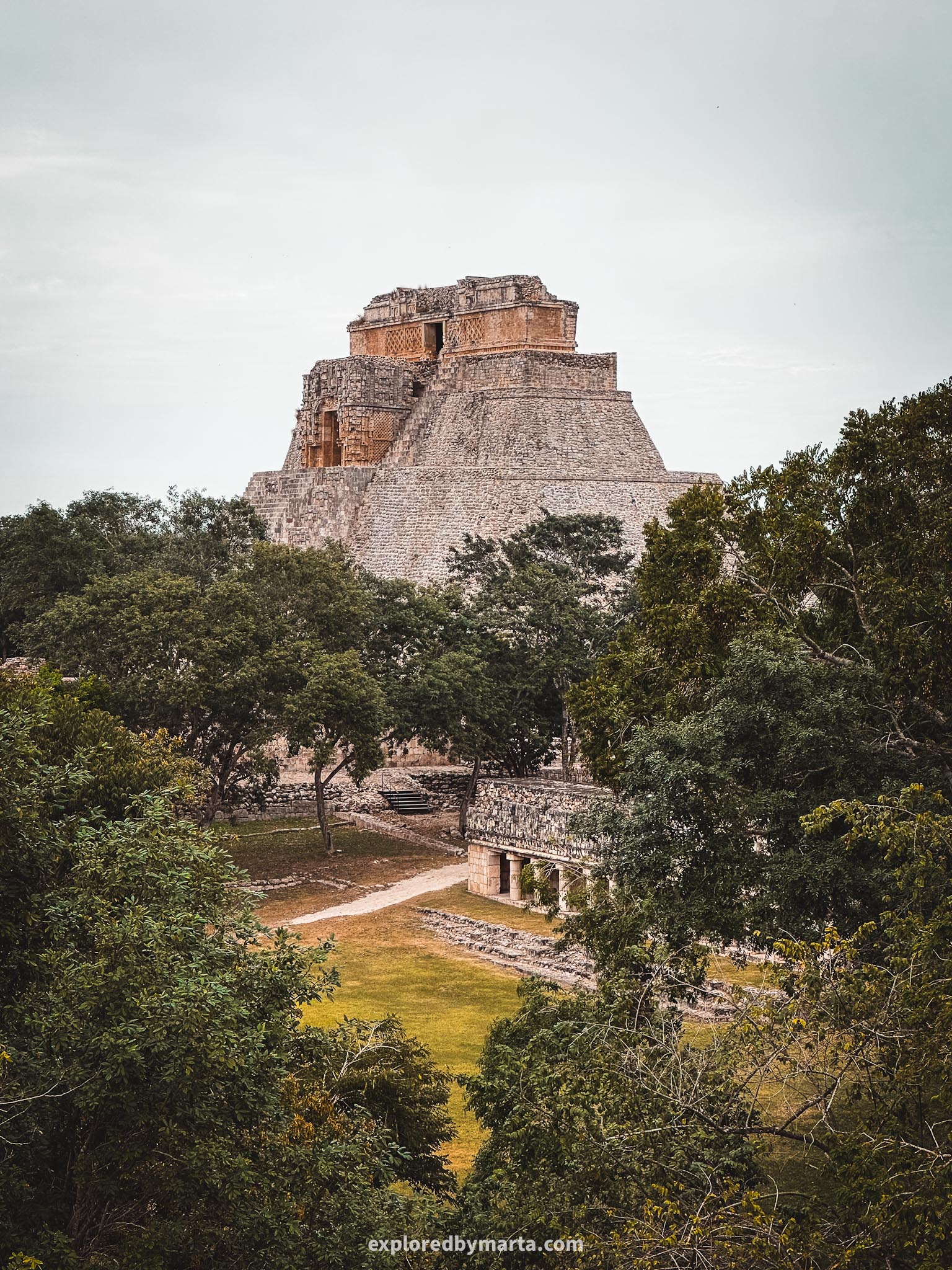
Uxmal at its peak was a city of 25 thousand people so the pyramid is not the only impressive building here. Definitely check out The Governor’s Palace located on a hill, Casa de las Palomas as well as the Nunnery Quadrangle.
The Nunnery Quadrangle has no connection to nuns. It is a courtyard surrounded by four palaces. When the Spanish conquistadors came they thought it looked like a convent thus the name. This is the best spot to see the Puuc architecture.
Despite the prices (we paid 530 pesos each), I loved exploring Uxmal. This was the first Mayan site we visited during our day tour from Merida to the Mayan cities in Ruta Puuc. I can see why some prefer this place instead of the overcrowded Chichen Itza.
Location: Uxmal Archaeological Zone
4. Ruta Puuc: Archaeological Zone of Kabah
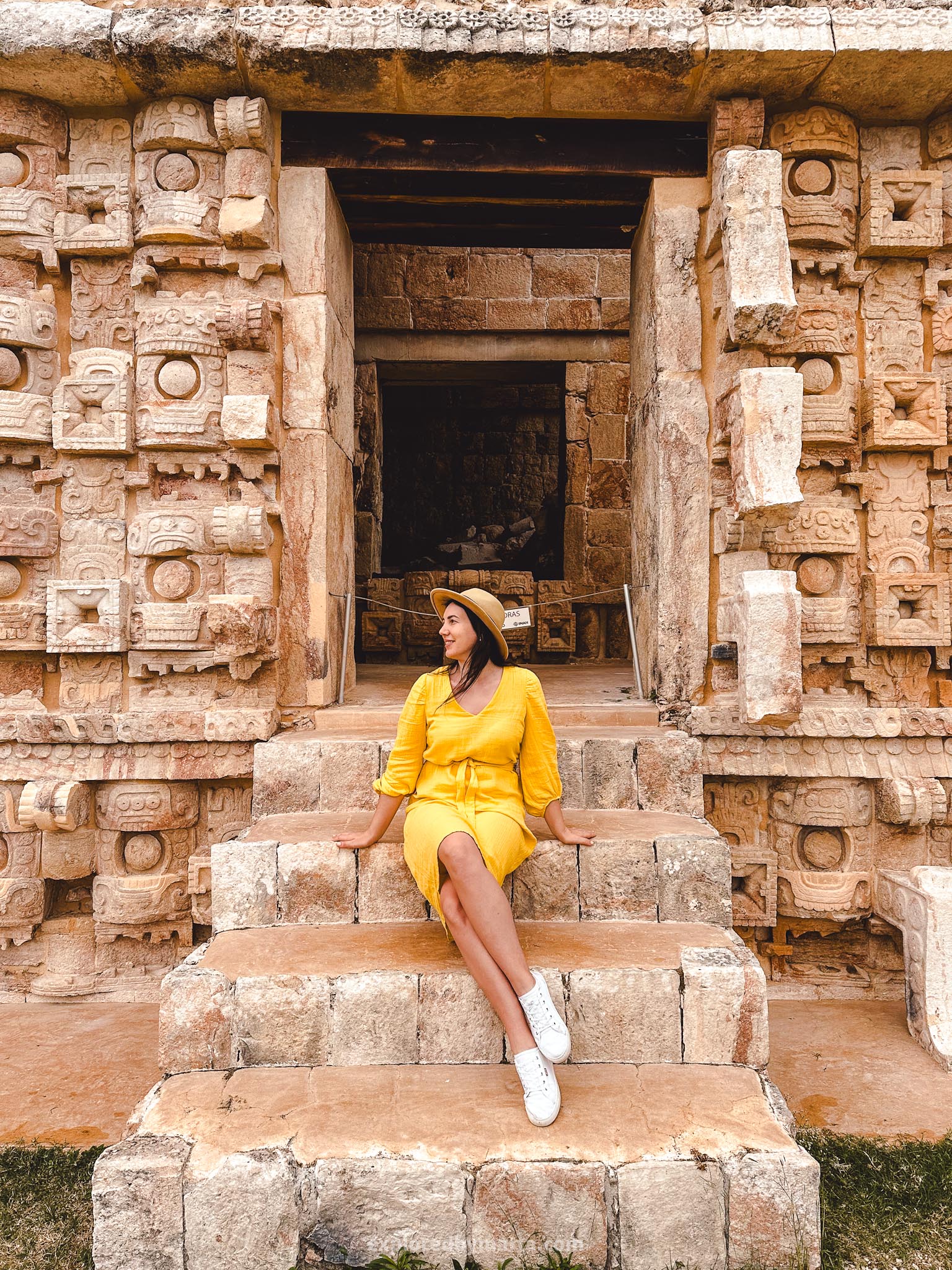
Kabah archaeological zone is another site of Mayan ruins in the Ruta Puuc route. Located just a 20-minute drive away from the Uxmal archaeological zone, Kabah is the second-largest site of the Puuc region.
We paid just 80 pesos per person for entry (in cash!) and no parking fee – a pleasant surprise for an archaeological site of this size after the skyscraper prices at Uxmal, Chichén Itzá, and Ek Balam.
Kabah also allows visitors to walk up close to the Mayan ruins to observe the architecture and we could even climb up to some of the structures (but not all of them!)! This experience definitely felt more intimate and special!


Kabah archaeological site does not have any impressive pyramids but it features a beautiful palace, temples, arches, and impressive examples of Puuc architecture – stone mosaics, geometric elements, elaborate sculptures, and the typical arch.
My favorite was the Codz Poop palace which is one of the largest structures here and allows you to admire the detailed Puuc architecture up close. The temple has a large wall covered with detailed stone mosaics (photo above).


The archaeological site has two parts – the majority of the buildings are located in one site but there is also a special Mayan arch on the other side of the road. It isn’t anything too special but we walked there anyway (it’s a 5-minute walk).
Being able to climb the ruins, see the architecture up close, and explore this site made it one of my favorite Mayan ruins near Merida. If you go to the Uxmal site, I highly recommend adding Kabah to your itinerary!
Location: Zona Arqueológica de Kabah
5. Ruta Puuc: Archaeological Zone of Sayil

Up next along the Ruta Puuc route in the Yucatán Peninsula is the archaeological zone of Sayil. For the entry, we paid 75 pesos each in cash. It is a remote site so don’t expect to get any cell service around here!
The site proudly boasts large Mayan ruins – the 85-meter-long Palace of Sayil that once was a home for a local royal dynasty. Sayil was a city between the years 800 to 950 in our era with a population of around 10 thousand people.


The Grand Palace has three levels. Although you cannot climb the palace, you can peek inside the rooms of the lower level (nothing’s inside!). There are a couple of other smaller ruins nearby like El Mirador temple about 400 meters from the palace.
The archaeological zone of Sayil is located just an 8-minute drive from the previous site – Kabah – and a 7-minute drive from its next neighbor – the archaeological zone of Xlapak. We spent about 30 minutes here. It was nice but not too memorable.
Location: Archaeological Zone of Sayil
6. Ruta Puuc: Archaeological Zone of Xlapak
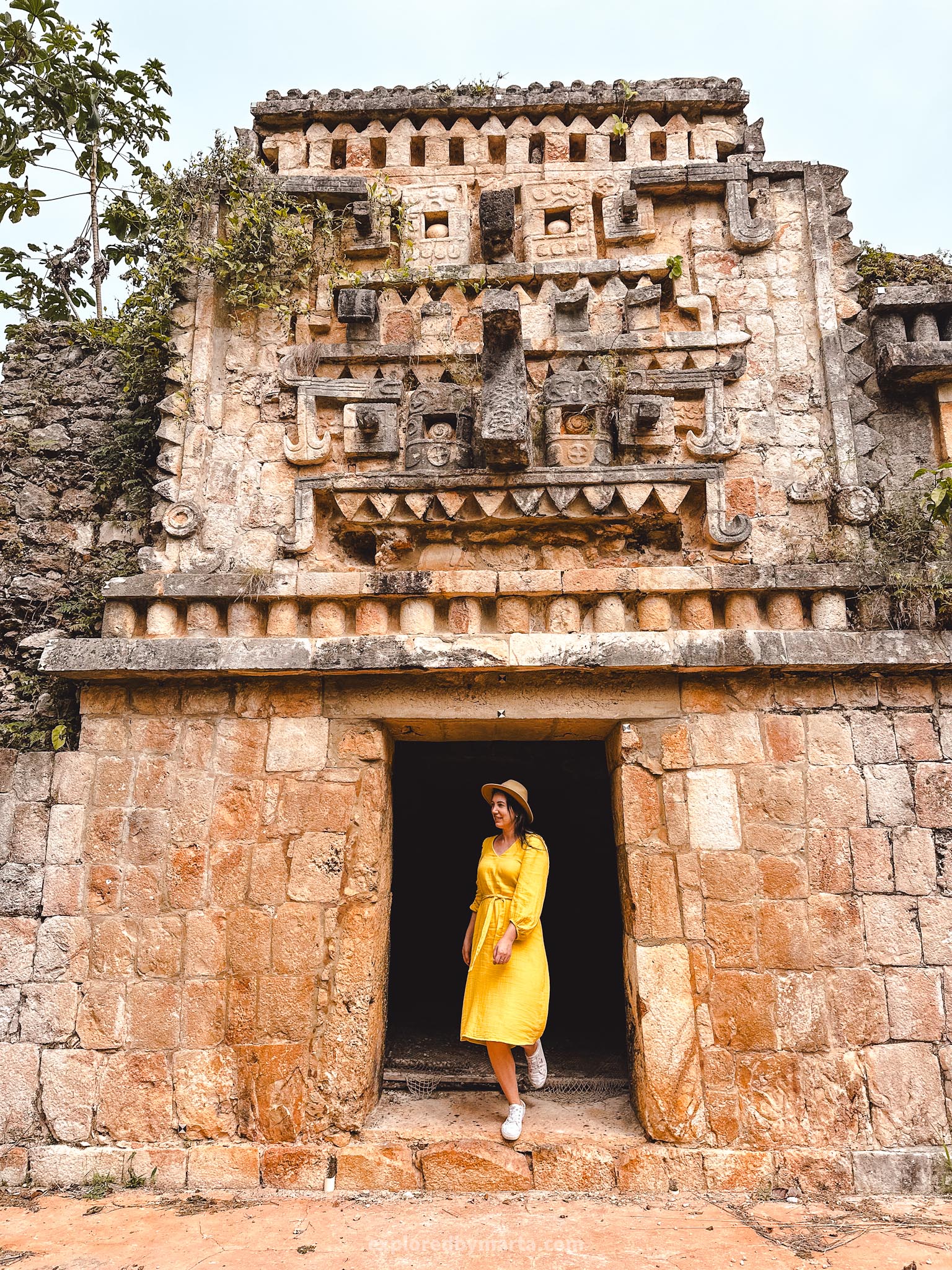

Xlapak archaeological zone is the smallest of all the Mayan ruins near Merida along the Ruta Puuc route. We paid another 75 pesos for the entry to visit a couple of nearly destroyed Mayan ruins dating back to the years 800-1000.
The archaeological site features a couple of palace-type buildings, however, they are very small and only one of them was really worth a visit (first photos). Other ‘palaces’ were either almost destroyed or not very impressive.


The first and most impressive palace features typical Puuc architecture – a simple rectangular building with a highly decorated upper part. The main palace features geometric elements and masks of the long-nose Yucatec Maya rain god Chaac.
Overall, if you have plenty of time and energy you can visit this place. We spent less than 30 minutes here (probably closer to 20 minutes). But if you have things to do and places to see, you can definitely skip this one.
Location: Archaeological Zone of Xlapak
7. Ruta Puuc: Archaeological Zone of Labná
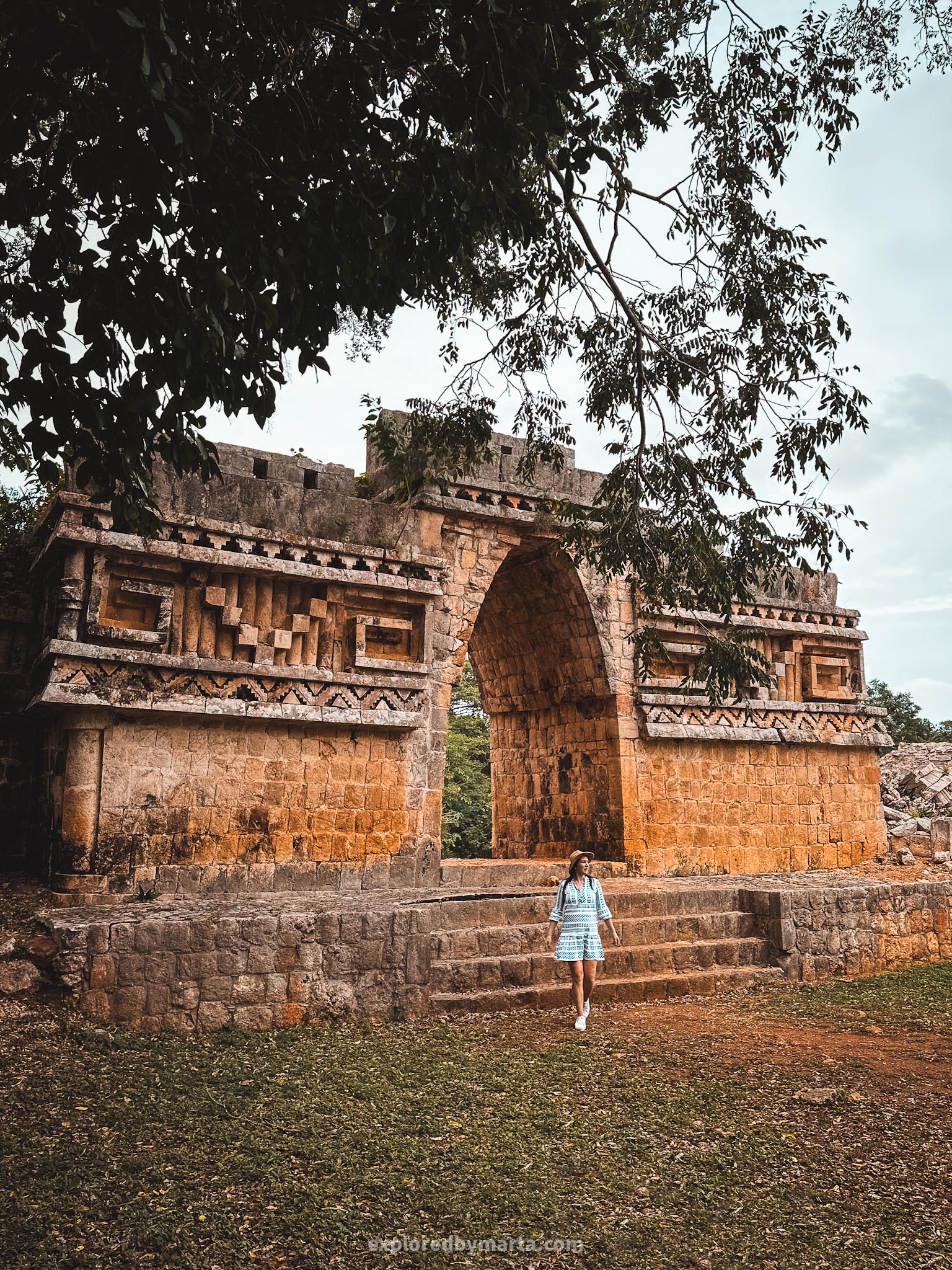
One may think that the further we went from the massive Uxmal archaeological zone the smaller and insignificant these other sites would get. Wrong! Labná archaeological zone turned out to be one of my absolute favorite Mayan ruins near Merida!
The archaeological zone proudly boasts three striking buildings – a large 120-meter-long two-storey palace El Palacio, the beautiful Gateway Arch, and the temple El Mirador (The Viewpoint) sitting atop a high pyramid-like structure.


The first building that you will see when you walk to the ruins is El Palacio. With 120 meters in length, it proudly stands as one of the longest Mayan structures in the Puuc region. You can walk up to the palace and even climb up on the roof of it!
Many doorways are open and you can take a look inside. The rooms often feature the typical shapes of arches in the Puuc architecture. You will see a long ceremonial road (‘sacbe’) stretching from the palace to other buildings on this site.
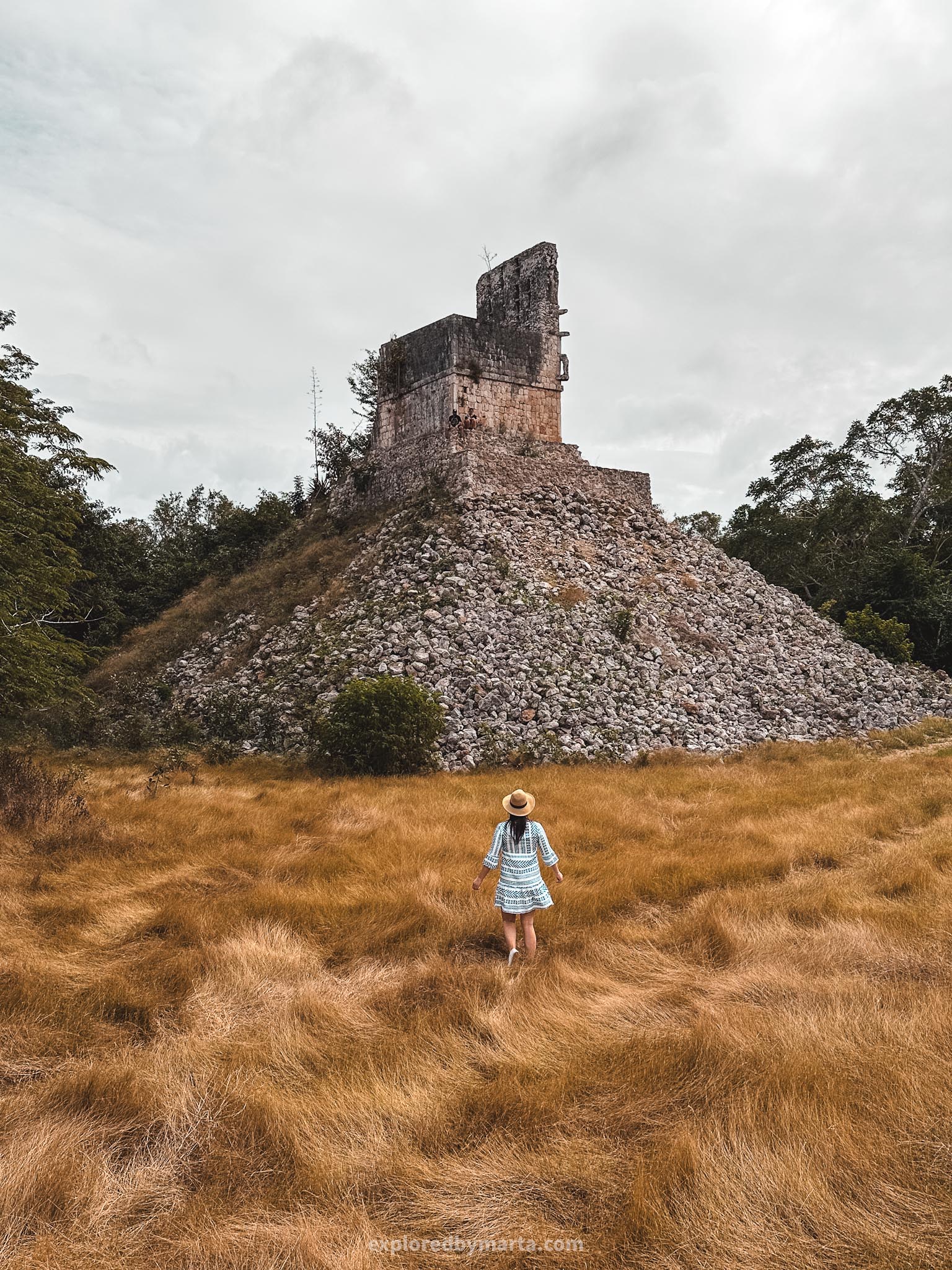

As you walk along the sacbe road you will find yourself next to two unique structures. One of them is the El Mirador temple. It sits on top of what looks like a stone pyramid. You can climb up there and get amazing views over the jungle!
Another building here is one of my favorites – the Gateway Arch (first photo). It is a 6-meter high well-preserved Mayan structure that served as a passageway. It features typical Puuc architectural elements – stone mosaics and geometric elements.
This Mayan site was built during the 8th and 9th centuries. There’s even a year 862 inscribed in the palace building. Out of all the Ruta Puuc Mayan sites, Labná, as well as Uxmal and Kabah were my favorites.
Location: Archaeological Zone of Labná
8. Zona Arqueológica Xcambó

Xcambó Archaeological Zone are less-visited Mayan ruins located just a 1-hour drive from Merida, Mexico. We paid 95 pesos each for entry and, as you can see from the photos, this is still one of the sites where you can climb the pyramids!
Xcambó was built between the years 350-550 and served as a commercial port as well as managed the salt mines. We drove there with our rental car during our three-week stay in Merida. This is definitely one of the lesser-known sites.
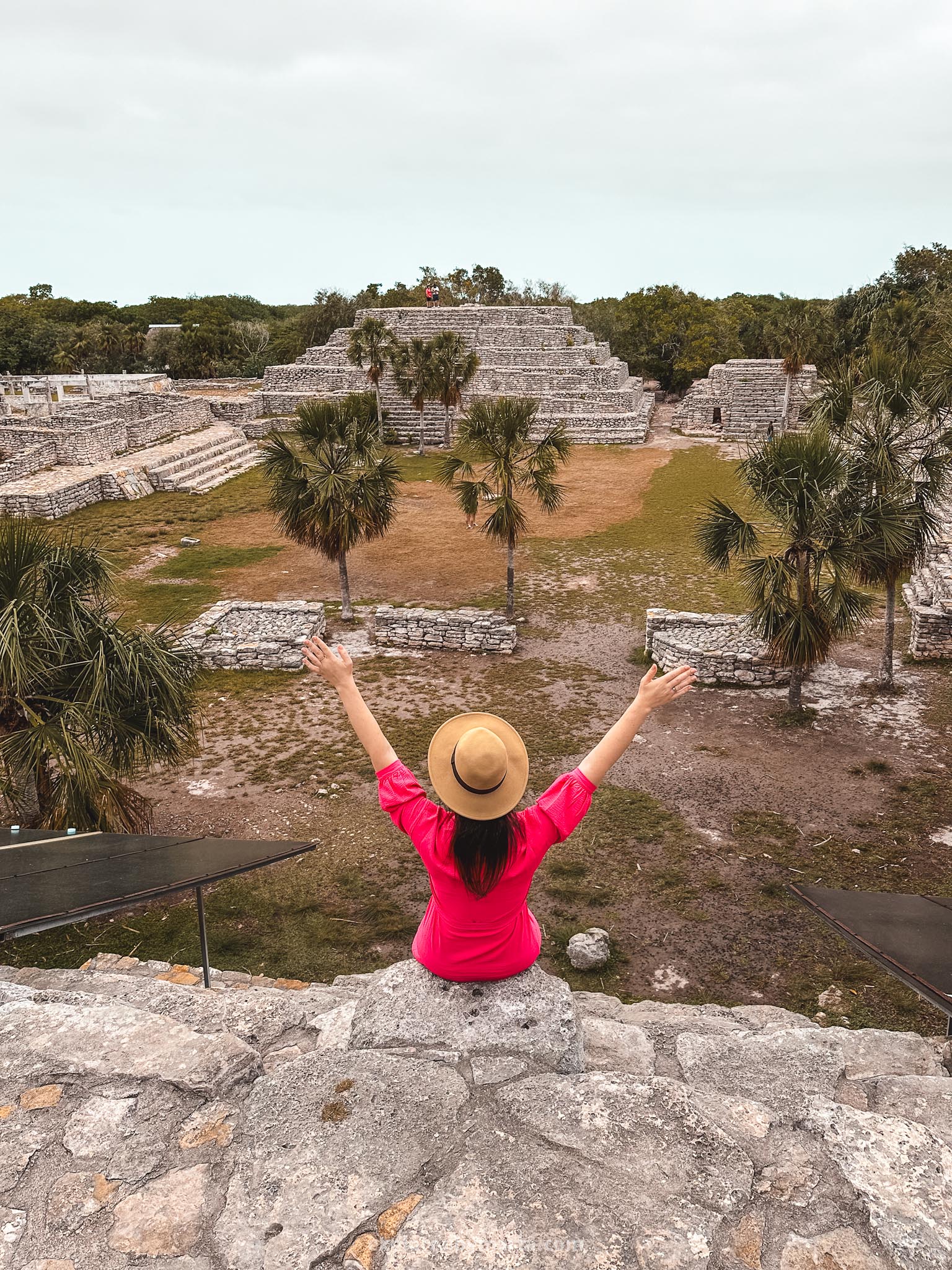
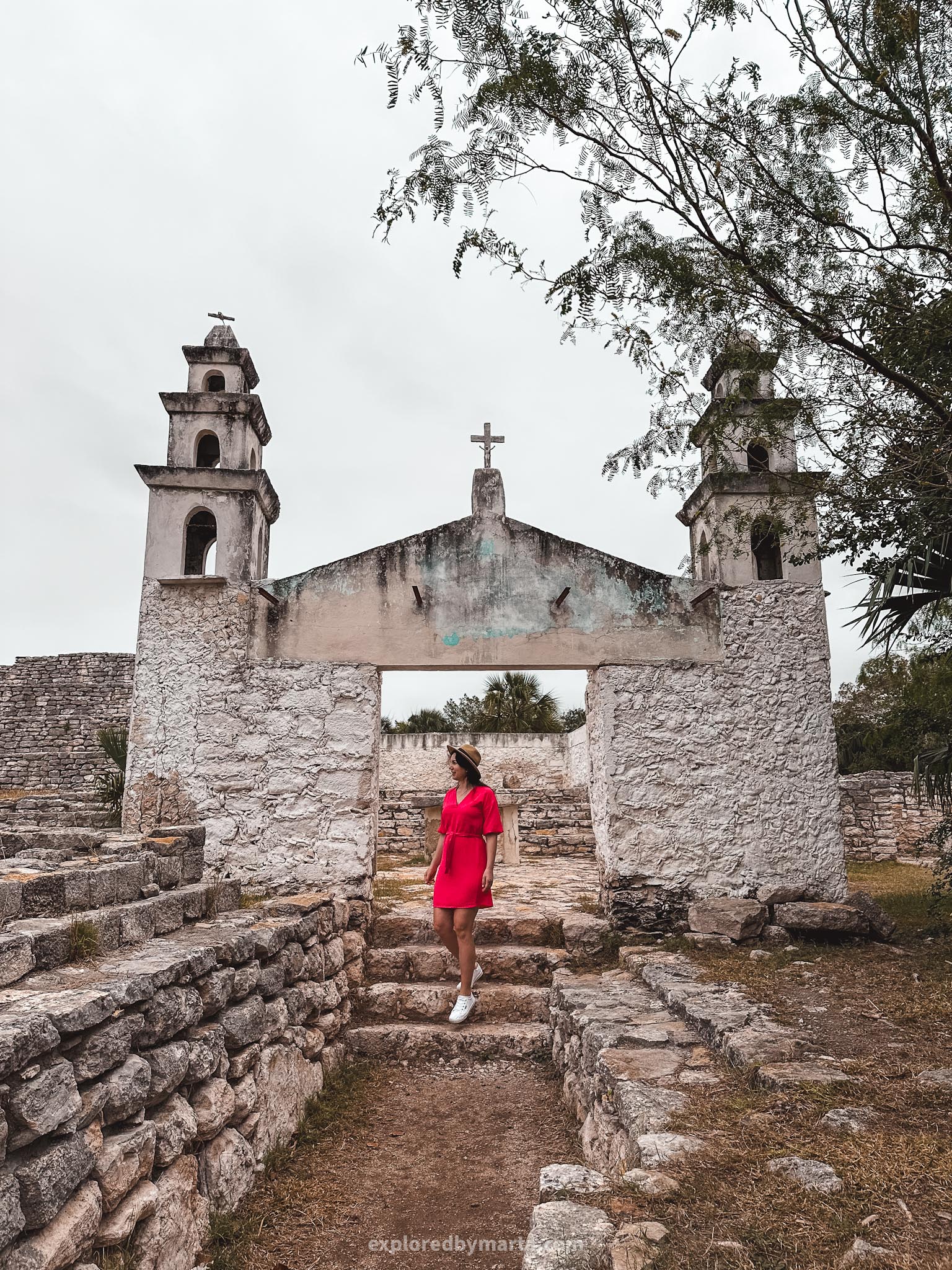
You are allowed to freely roam around the village exploring all the buildings and pyramids. There are several platforms, temples, and also bigger and smaller pyramids where you are allowed to climb up to the top.
This was actually the first archeological site that we visited in Yucatán and holds a special place in my heart. Maybe because this was the place where I climbed a Mayan pyramid for the first time in my life, haha!
Location: Zona Arqueológica Xcambó
9. Kinich Kakmó Pyramid
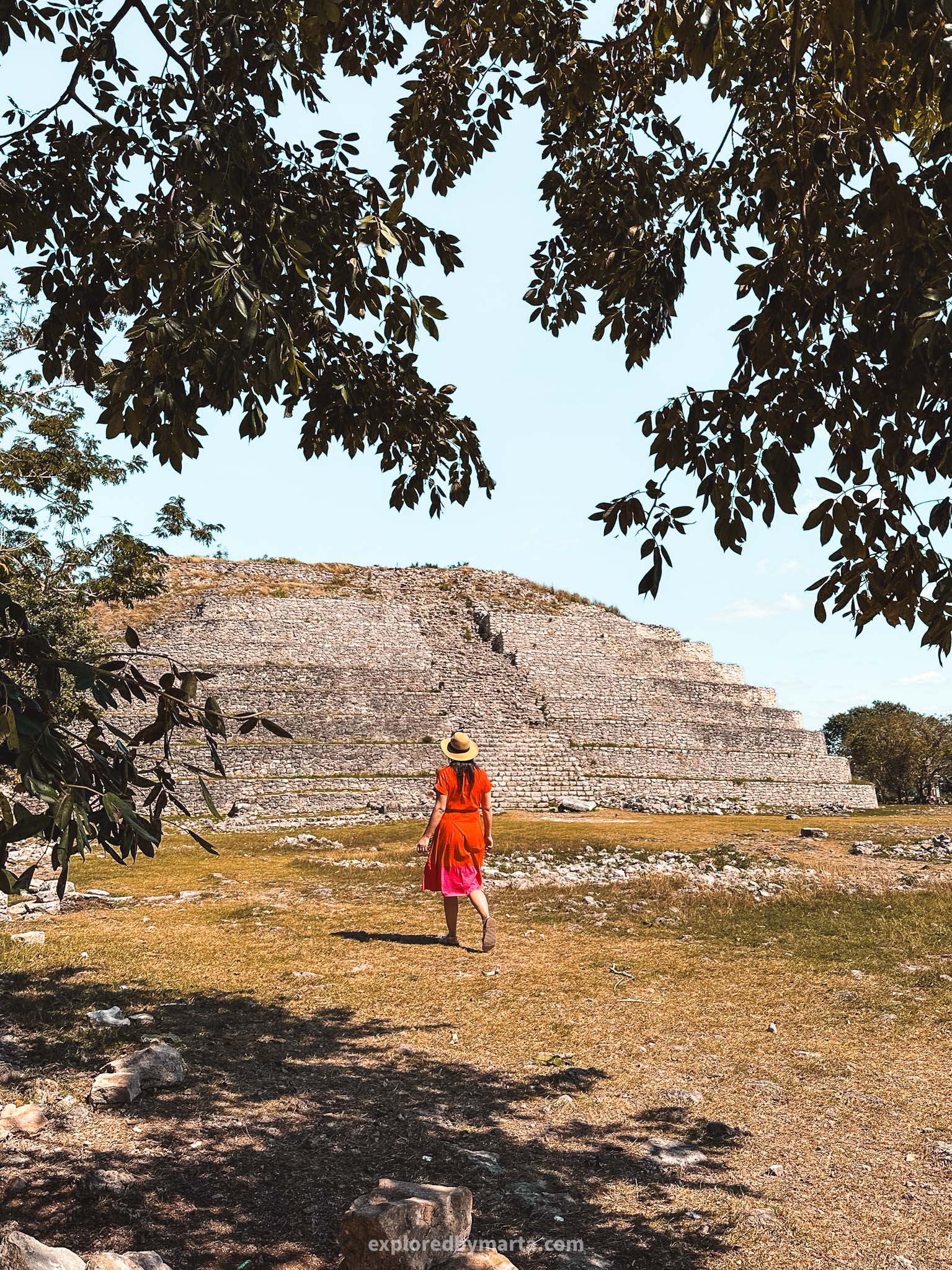
Did you know that Izamal city, located just 1 hour drive from Merida, which is famously known as the Yellow City, is also called the City of Hills? Let me tell you a secret! Those are not just hills. The ‘hills’ are the remains of ancient Mayan pyramids!
Most of the pyramids and archeological sites in Izamal are destroyed but there are two quite large Mayan pyramids worth seeing that you will find amongst the best places to visit in Izamal, Mexico. The best part? You can climb them and visit them for free!


Kinich Kakmó Pyramid is the largest Mayan pyramid in Izamal and one of the largest pyramids in Mexico. It measures 200 meters long and 180 meters wide. The pyramid was built between 400 and 600 in our era and was dedicated to the Maya sun god.
Kinich Kakmo pyramid was one of my favorite places in Izamal. Besides, there is no entrance fee and you can enter the territory for free. Just check their working hours as there is a gate that is closed during the night!
My favorite thing about the Kinich Kak Moo pyramid is that you are allowed to climb up to the top of the pyramid – something that is no longer allowed in many archeological sites in the Yucatán Peninsula. And you can see the entire Izamal from the top!
Location: Kinich Kakmó Pyramid
10. Itzamatul Pyramid


Itzamatul is another Mayan pyramid in the yellow town of Izamal. Itzamatul uncovers three stages of construction. Some parts of it date back to 950-1150 AC, other parts were built between 700-850 AC but the third stage took place around 400-600 AC.
It is said that Itzamatul Pyramid was built for the Mayan god Zamná and the pyramid attracted many pilgrims that traveled to this site. Today you can visit this ancient Izamal pyramid sitting in the center of town for free and even climb to the top of it.
Although it is not as impressive and not as high and massive as Kinich Kakmó Pyramid, it was still worth a visit. However, if you are short on time, you can skip the Itzamatul Pyramid and prioritize the Kinich Kakmó Pyramid just 500 meters away.
Location: Itzamatul Pyramid
11. Archaeological Zone of Dzibilchaltún
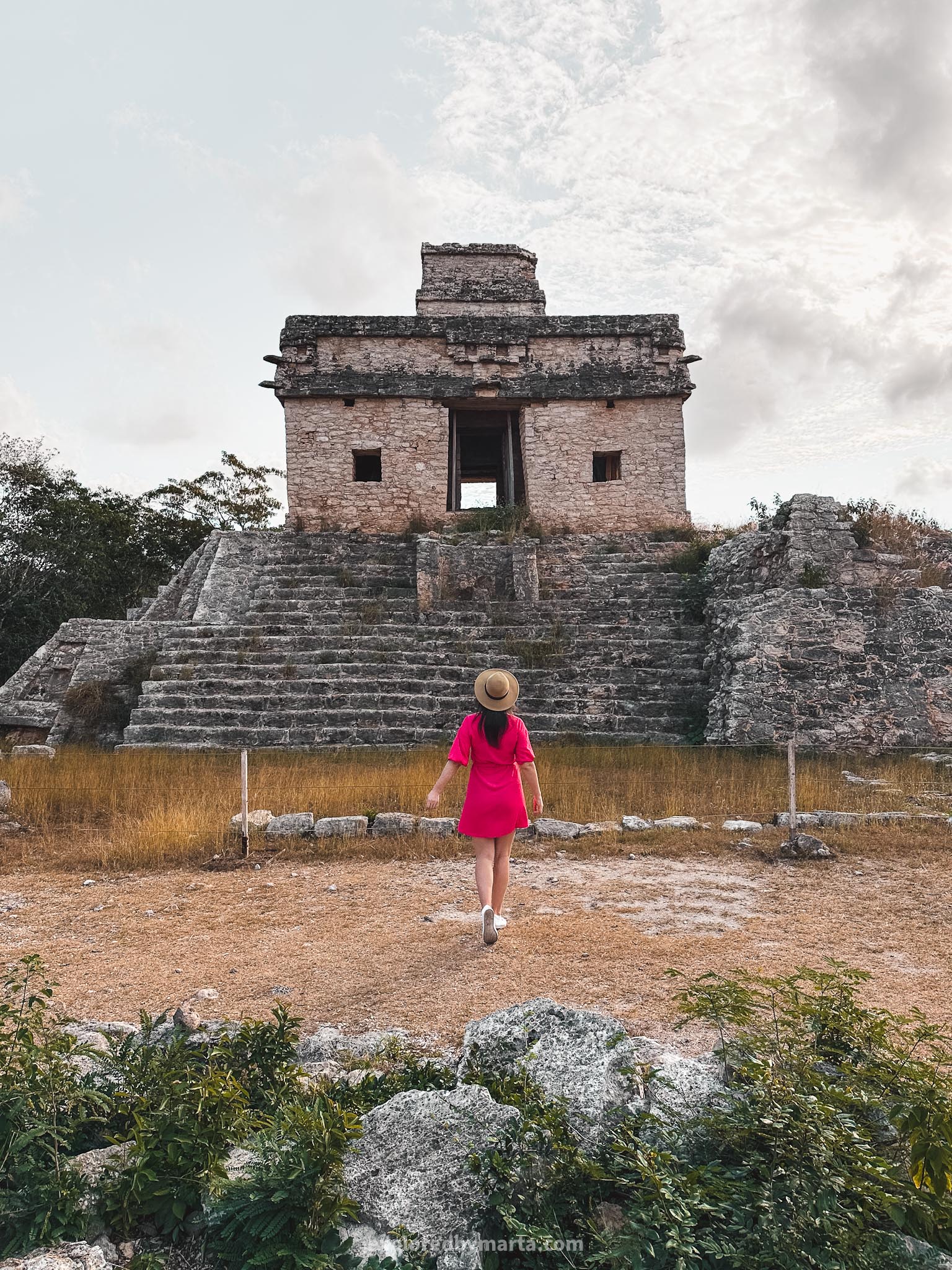
Dzibilchaltun ruins are located a short 20 to 30-minute drive from Merida. Dzibilchaltún from the Mayan language signifies a place where there are writings on the stones. It is best known for the Temple of the Seven Dolls or the Temple of the Sun.
Apart from the famous temple, the site also features a pyramid, and a couple of other structures as well as a cenote and a museum that were closed to visitors when we visited. It also features a 16th-century Franciscan chapel in the middle of the site.

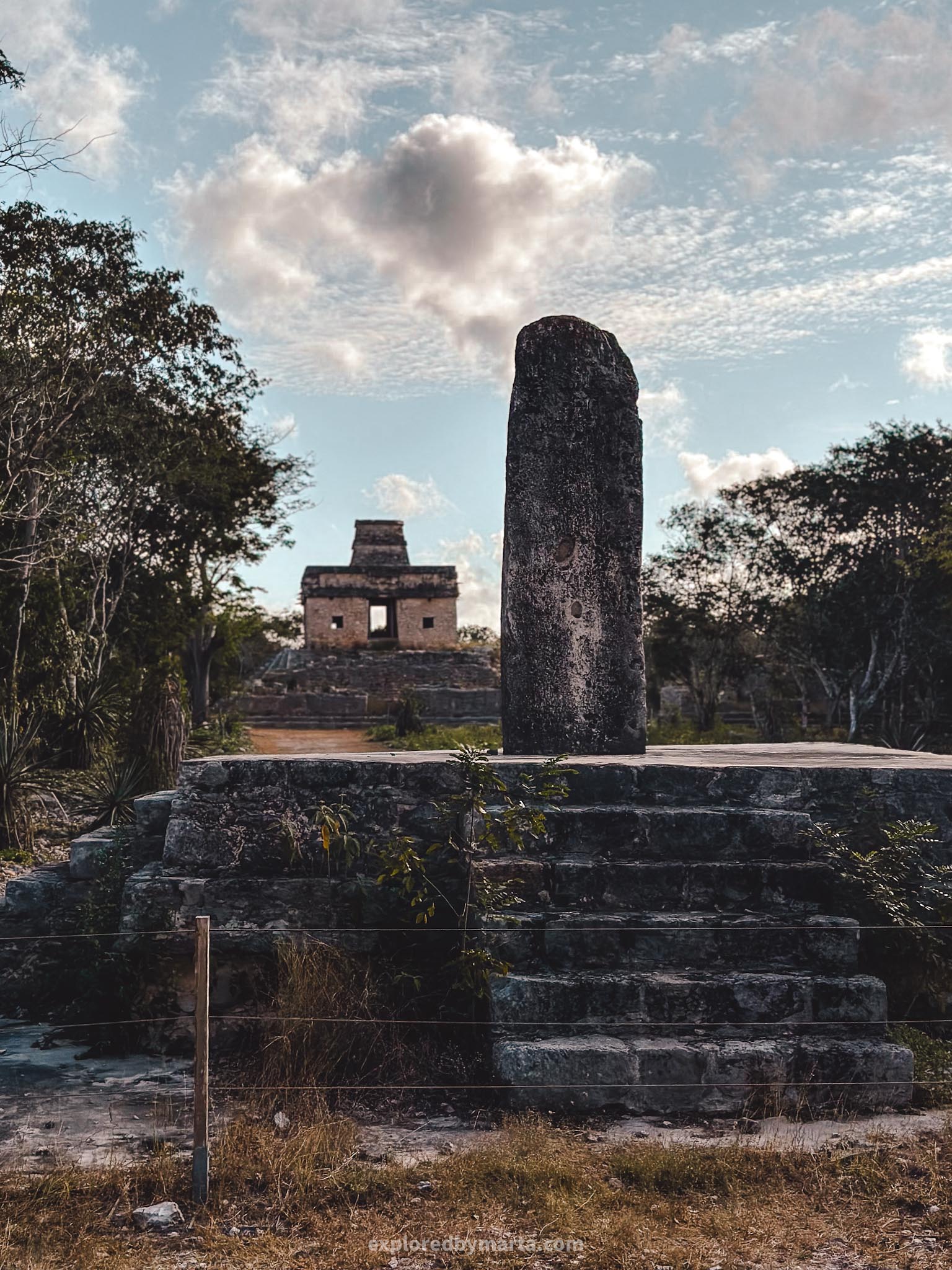
The most interesting part of the Temple of the Sun is that it is built in alignment with the equinox happening on March 21 and September 21. At dawn, the Sun appears right in the middle of the temple door proving Mayan knowledge of astronomy.
Although many of the structures that you can see today in the Dzibilchaltún archaeological zone date back to the 9th-11th centuries, there are artifacts found around and inside the cenote dating back as far as around 600 BC.
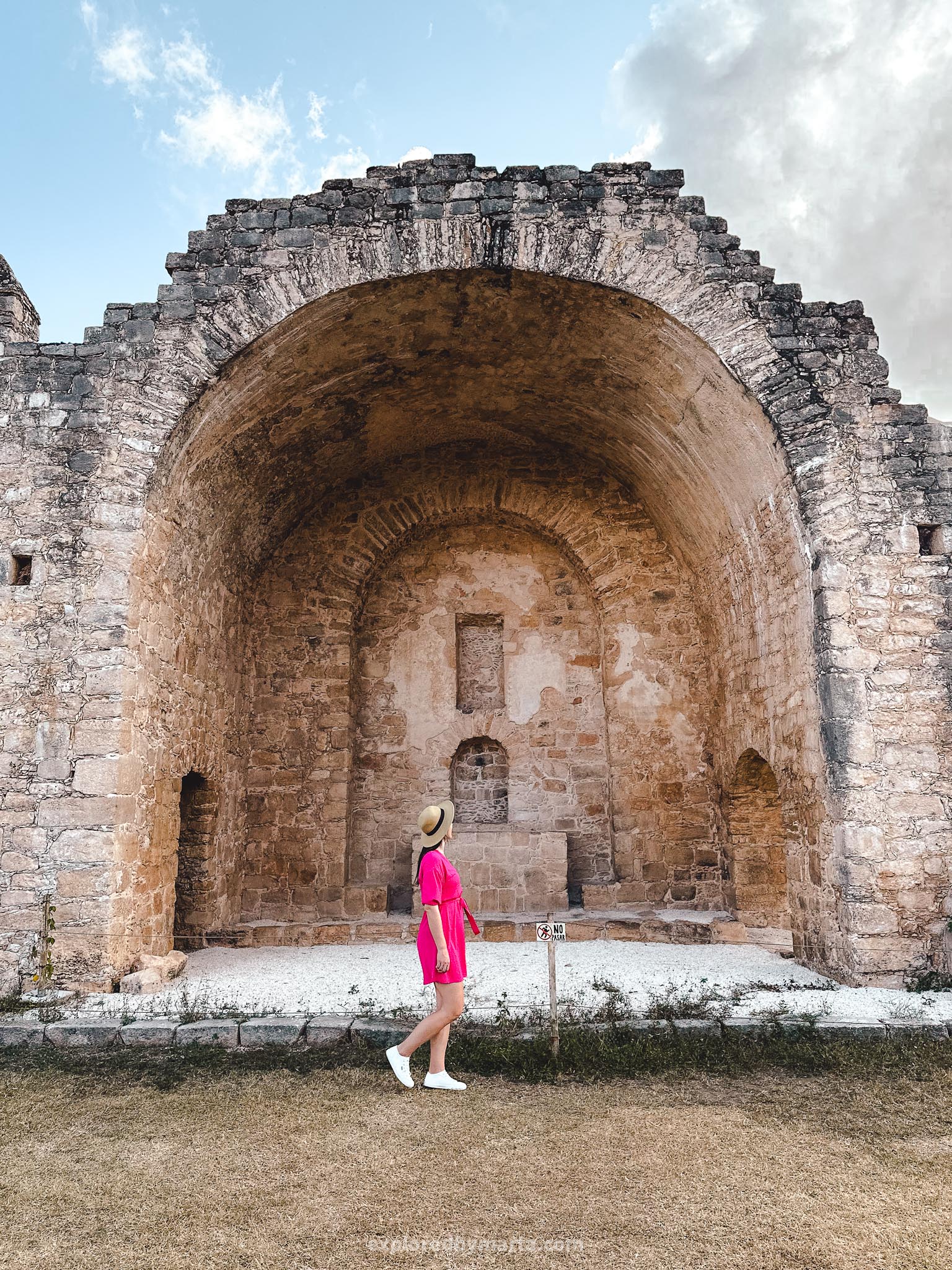
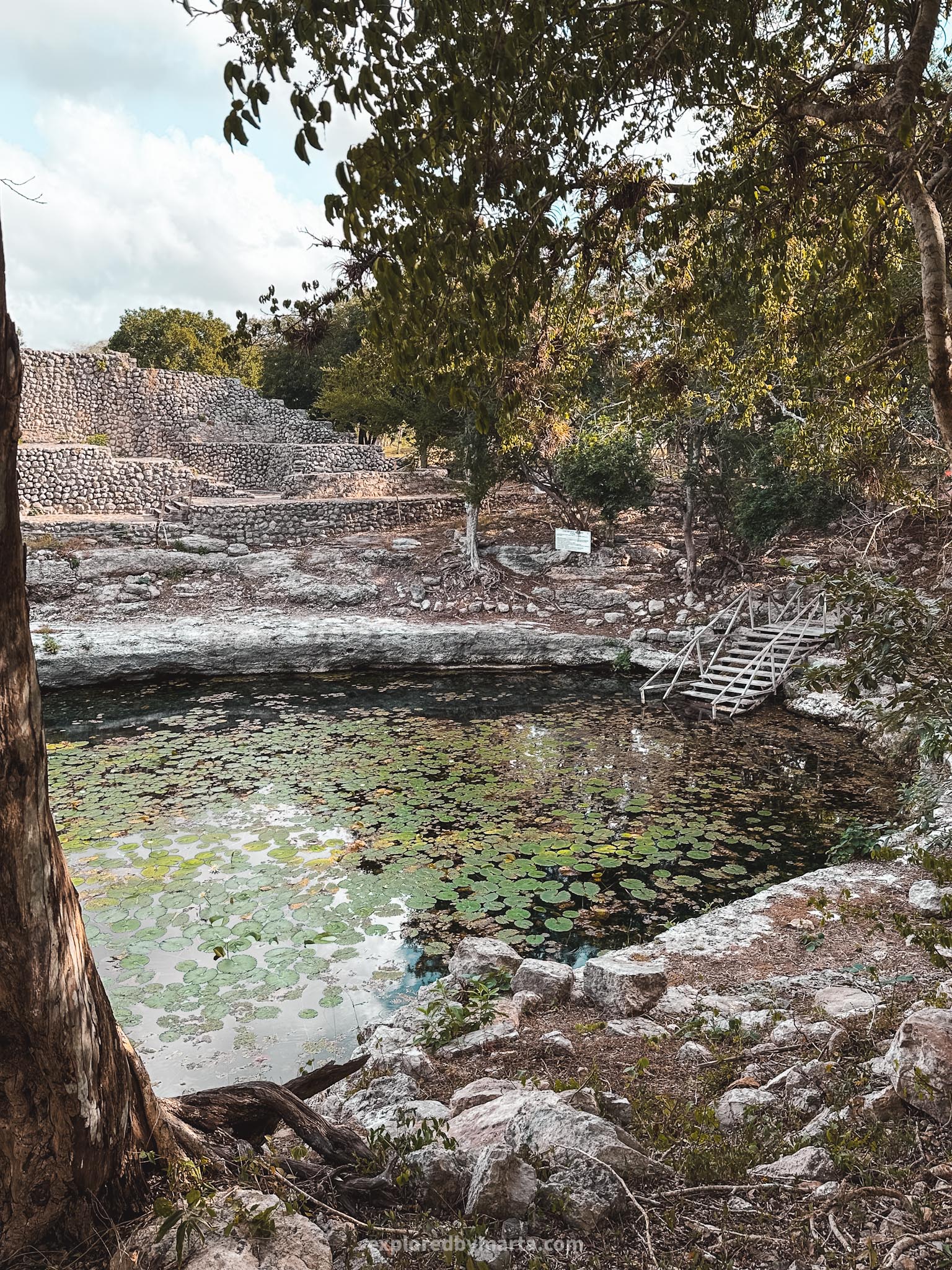
You cannot access the Temple of the Sun but you can climb other structures in Dzibilchaltún. There is a smaller pyramid as well as other Mayan structures to climb and observe from above what was once an ancient city with 25 thousand people.
Overall I wasn’t impressed by this site and by entry fees. We paid more than 100 pesos for parking and then more than 300 pesos per person for entry which seems too expensive for a smaller site. It is your choice!
Location: Archaeological Zone of Dzibilchaltún
Bonus! Archaeological Site of Mayapan
If there is one thing to know about the archaeological sites in the Yucatán Peninsula it is that you have to make sure they are actually open before you travel there. Just open their location on Google Maps and look for the latest reviews!
It is not uncommon to see protests and blockades by locals or local organizations which result in these archaeological sites being closed. In recent years they even closed down Chichen Itza and nobody could visit.
During our stay in Merida, we wanted to visit one of the most beautiful archaeological sites – Mayapan. However, due to the protests, it had been closed for months and months. If you can, do check it out and pay a visit if it is open!
Location: Archaeological Site of Mayapan
Read more about Merida and Mexico!
- Merida bucket list: 21 best things to do in Merida, Mexico
- 17 most iconic Instagram spots in Merida, Mexico
- 15 best day trips from Merida, Mexico
- Ring of Cenotes: 15 beautiful cenotes near Merida, Mexico
Happy exploring!
We stayed in Merida for three weeks so that we could explore the city and the surroundings in a more relaxed way. And discovering all the beautiful Mayan ruins near Merida was one of my absolute highlights from our stay there!
Besides our stay in the colorful and vibrant Merida, we also spent a couple of months traveling around the Yucatán Peninsula, including the states of Yucatán and Quintana Roo, and exploring everything this beautiful peninsula had to offer.
From white-sand beaches to dark underground cenotes, and ancient pyramids – there’s just so much to see! I hope you enjoy your time there as much as we did and I hope you get some travel inspiration from this blog post for your travels! Happy exploring!
PIN FOR LATER!
